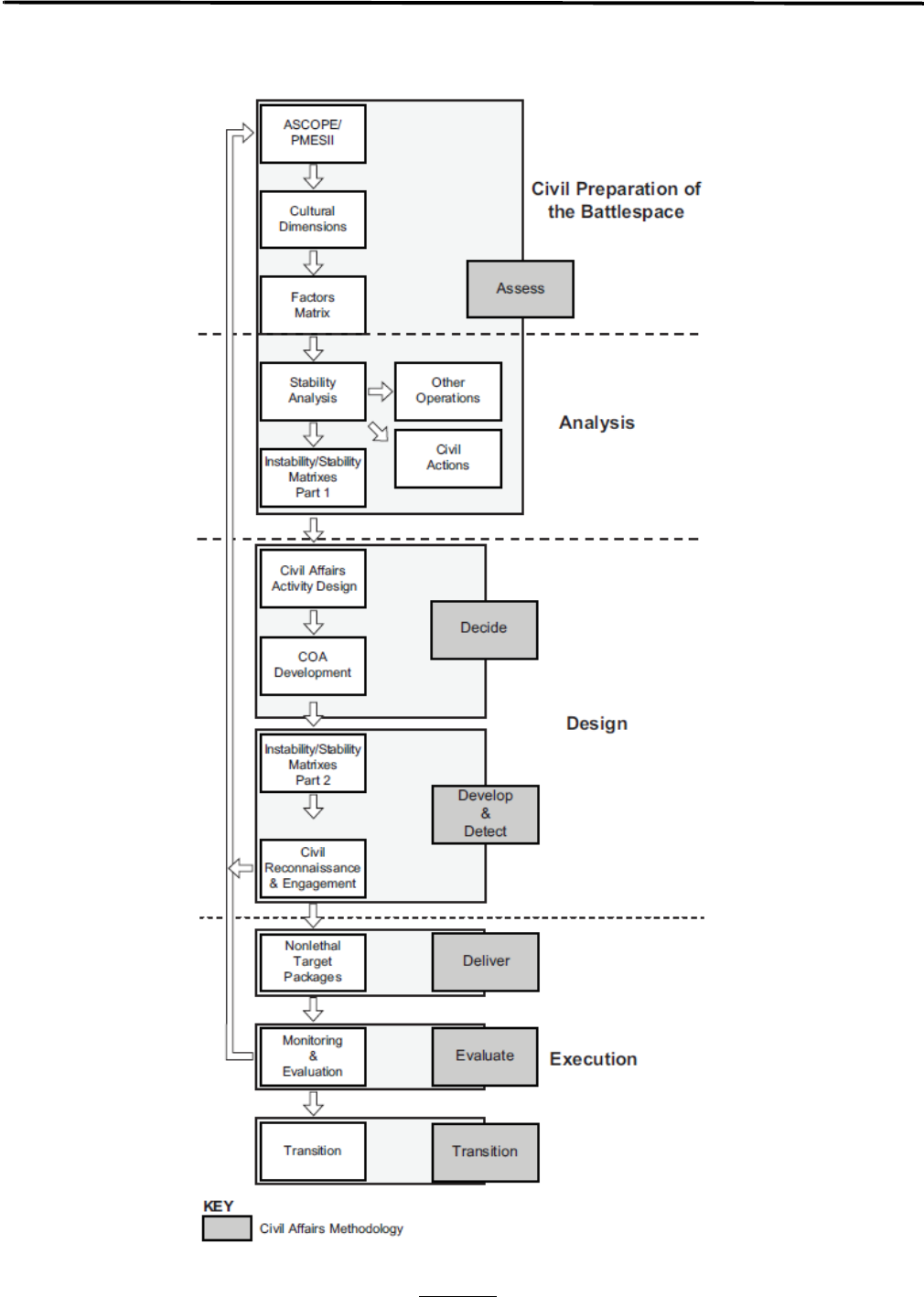
USMC
USMC
DISTRIBUTION STATEMENT A: Approved for public release; distribution is unlimited.
PCN 143 000177 00
MCWP 3-03
U.S. Marine Corps
Stability Operations

DEPARTMENT OF THE NAVY
Headquarters United States Marine Corps
Washington, D.C. 20350-3000
4 April 2018
CHANGE 1 to MCWP 3-03
Stability Operations
1. This publication has been edited to ensure gender neutrality of all applicable and appropriate
terms, except those terms governed by higher authority. No other content has been affected.
2. File this transmittal sheet in the front of this publication.
Reviewed and approved this date.
BY DIRECTION OF THE COMMANDANT OF THE MARINE CORPS
ROBERT S. WALSH
Lieutenant General, U.S. Marine Corps
Deputy Commandant for Combat Development and Integration
Publication Control Numbers:
Publication: 143 000177 00
Change: 143 000177 01

DEPARTMENT OF THE NAVY
Headquarters United States Marine Corps
Washington, D.C. 20350-3000
16 December 2016
FOREWORD
The Marine Corps will continue, with increasing frequency, to conduct activities in support of
stability operations. These operations will span the range of military operations, from peacetime
engagement, to limited contingencies and crisis response, to major operations and campaigns.
During periods of relative calm, combatant commanders will use Marine Corps operating forces,
either Marine air-ground task forces or other task-organized force packages, in support of our
national strategy of engagement. This aspect of our national strategy assists in building host nation
capacities, promotes democracy and the rule of law, and builds understanding of our cultures.
Beyond peacetime engagement, Marine Corps operating forces will participate in both limited
contingency and crisis response stability operations. The expeditionary nature of the Marine
Corps and its role as the nation’s force-in-readiness demands Marines prepare to conduct stability
operations of short or long duration. Participants working with Marines will come from many
organizations such as host nation personnel, various United States Government agencies,
multinational forces, nongovernmental organizations, and private volunteer organizations.
Marine Corps Warfighting Publication 3-03, Stability Operations, codifies tasks, planning
considerations, and other considerations for use by the Marine air-ground task force in stability
operations. It is a result of lessons learned through the development of the joint irregular warfare
capability based assessment and responds to the Department of Defense directive that distinguishes
irregular warfare from traditional warfare. Stability operations are one of a variety of steady-state
and surge Department of Defense irregular warfare and small wars activities and operations.
Reviewed and approved this date.
BY DIRECTION OF THE COMMANDANT OF THE MARINE CORPS
ROBERT S. WALSH
Lieutenant General, U.S. Marine Corps
Deputy Commandant for Combat Development and Integration
Publication Control Number: 143 000177 00
DISTRIBUTION STATEMENT A: Approved for public release; distribution is unlimited.

MCWP 3-03 Stability Operations
ii
Table of Contents
Chapter 1. Overview
Fundamentals..............................................................................................................................................1-1
Stability Operations as a Core US Military Mission ..................................................................................1-3
Stability Operations Response Actions ......................................................................................................1-4
Providing Initial Response ...................................................................................................................1-4
Effecting Transformation.....................................................................................................................1-4
Fostering Stability ................................................................................................................................1-4
Marine Corps Approach to Stability Operations ........................................................................................1-5
Etymology............................................................................................................................................1-5
Aspects of Stability Operations............................................................................................................1-6
MAGTF Execution of Stability Operations .........................................................................................1-6
Stability Operations Tenets.........................................................................................................................1-7
Stability Operations Criteria.......................................................................................................................1-8
Chapter 2. Functions and Tasks
Functions.....................................................................................................................................................2-1
Tasks...........................................................................................................................................................2-2
Establish Civil Security........................................................................................................................2-3
Provide Humanitarian Assistance ........................................................................................................2-5
Support and/or Provide Restoration of Essential Services...................................................................2-6
Support Establishment of Civil Control...............................................................................................2-6
Support Economic and Infrastructure Development............................................................................2-8
Support to Governance.......................................................................................................................2-10
Chapter 3. Planning for Stability Operations
Unified Action ............................................................................................................................................3-1
Civil-Military Operations ...........................................................................................................................3-2
Integration of Information and Communication.........................................................................................3-3
Assessment .................................................................................................................................................3-3
Initial Assessment ................................................................................................................................3-4
Operational Assessment .......................................................................................................................3-4
Assessment Frameworks and Models ..................................................................................................3-4

MCWP 3-03 Stability Operations
iii
Transitions ..................................................................................................................................................3-7
Funding Stability Operations......................................................................................................................3-8
Legitimacy ..................................................................................................................................................3-8
Restraint......................................................................................................................................................3-9
Chapter 4. Maritime Stability Operations
Understanding Maritime Stability Operations............................................................................................4-1
Maritime Stability Operations: A Legal Understanding.............................................................................4-3
United States Code .....................................................................................................................................4-3
Sources of Instability in the Maritime Environment ..................................................................................4-4
Traditional State Challenges ................................................................................................................4-4
Terrorist Challenges.............................................................................................................................4-4
Transnational Crime and Piracy Challenges........................................................................................4-5
Natural Disasters ..................................................................................................................................4-5
Environmental Destruction ..................................................................................................................4-6
Illegal Seaborne Migration...................................................................................................................4-6
The United States Naval Service ................................................................................................................4-6
Maritime, Stability-Related Tasks..............................................................................................................4-7
Aid to Distressed Mariners Operations ................................................................................................4-7
Antipiracy Operations ..........................................................................................................................4-7
Arms Control........................................................................................................................................4-8
Counter Illicit Trafficking (Drugs, Weapons of Mass Destruction, Humans).....................................4-8
Counterpiracy.......................................................................................................................................4-8
Emergency Repair of Maritime Infrastructure.....................................................................................4-8
Exclusion Zone Enforcement...............................................................................................................4-8
Expeditionary Diving and Salvage.......................................................................................................4-9
Explosive Ordnance Disposal ..............................................................................................................4-9
Freedom of Navigation and Overflight Operations .............................................................................4-9
Gas-Oil Platform ..................................................................................................................................4-9
Maritime Counterterrorism ..................................................................................................................4-9
Maritime Interception...........................................................................................................................4-9
Mine Countermeasures.........................................................................................................................4-9
Offshore Resource Protection ............................................................................................................4-10
Port Security.......................................................................................................................................4-10
Show of Force ....................................................................................................................................4-10
Vessel Escort......................................................................................................................................4-10
Visit, Board, Search, and Seizure.............................................................................................
..........4-11

MCWP 3-03 Stability Operations
iv
Appendices
A Strategic-Level Guidance and Policy............................................................................................. A-1
B Stability Assessment Framework ................................................................................................... B-1
Glossary
References and Related Publications

MCWP 3-03 Stability Operations
1-1
CHAPTER 1
OVERVIEW
FUNDAMENTALS
In 2005, Department of Defense Directive (DODD) 3000.05, Military Support for Stability,
Security, Transition, and Reconstruction Operations, established stability operations as a core
US military mission and directed the US forces to prepare to conduct these types of operations
with a level of proficiency equivalent to combat operations. In 2009, the directive was revised and
re-issued as Department of Defense Instruction (DODI) 3000.05, Stability Operations. This
instruction directed the Department of Defense (DOD) to be prepared to—
“Conduct stability operations activities throughout all phases of conflict and across the range
of military operations, including in combat and non-combat environments. The magnitude
of stability operations missions may range from small-scale, short-duration to large-scale,
long-duration.”
“Support stability operations activities led by other [United States Government (USG)]
departments or agencies . . . , foreign governments and security forces, international
governmental organizations, or when otherwise directed.”
“Lead stability operations activities to establish civil security and civil control, restore essential
services, repair and protect critical infrastructure, and deliver humanitarian assistance [HA] until
such time as it is feasible to transition lead responsibility to other [USG] agencies, foreign
governments and security forces, or international governmental organizations . . . .”
Stability operations are presently defined as “an overarching term encompassing various military
missions, tasks, and activities conducted outside the continental United States [OCONUS] in
coordination with other instruments of national power to maintain or re-establish a safe and secure
environment, provide essential governmental services, emergency infrastructure reconstruction,
and humanitarian relief” (Joint Publication [JP] 1-02, Department of Defense Dictionary of
Military and Associated Terms). Stability operations capitalize on coordination, cooperation, and
integration among military and nonmilitary organizations. These complementary civil-military
efforts aim to strengthen legitimate governance, restore or maintain the rule of law, support
economic and infrastructure development, and foster a sense of national unity that enable the host
government to assume responsibility for civil administration. See appendix A for more
information on guidance and policy at the strategic level.

MCWP 3-03 Stability Operations
1-2
Several aspects of stability operations deserve emphasis and explanation:
Stability operations are an overarching term. Stability operations include many subordinate
missions, tasks, and activities. Stability-related activities include broad functions, such as
support to governance and stabilization, economic development, rule of law, civil security,
and foreign humanitarian assistance (FHA).
Stability operations encompass various actions conducted outside of the continental United
States. The underlying premise of stability operations is that a stable world presents fewer
threats when compared to a world with pockets of instability. The aim of stability operations
is to remove the underlying source of instability and create opportunities for a safer and more
secure environment. While the focus of stability operations is OCONUS, these operations
often contribute indirectly to the defense and security of the United States.
Stability operations are conducted in coordination with other instruments of national power.
Whole of government approaches (i.e., all pertinent USG departments and agencies) are
required in stability operations. Stability operations conducted in countries
with an US ambassador are conducted with ambassadorial (or deputy chief of mission)
coordination and approval. These various missions, tasks, and activities may involve
participation from a large number of USG departments and agencies, intergovernmental
organizations (IGOs), nongovernmental organizations (NGOs), other nations, US
ambassadors, and multinational forces.
Stability operations are conducted to maintain or to re-establish a safe and secure environment
and provide essential governmental services, emergency infrastructure reconstruction, and
humanitarian relief. This important dimension of stability operations acknowledges support to
maintain stability in some situations, while in others, to re-establish stability. Stability operations
align efforts to provide essential government services, emergency infrastructure reconstruction,
and humanitarian relief making them preventive, as well as responsive, to instability.
The term “stability operation” can be used in three different contexts. The term may refer to phase
four of the joint campaign construct: stabilize. The term may be used to describe a joint operation
or major campaign. The term may also be used to describe a series of activities conducted
simultaneously with other types of operations as described in, Irregular Warfare (IW), which
states that DOD stability operations may be included as one of a “variety of steady-state and surge
DOD activities and operations . . . that, in the context of IW [irregular warfare], involve
establishing or re-establishing order in a fragile state.”
In general, a military operation is a set of actions intended to accomplish a task or mission.
Although the US military is organized, trained, and equipped for sustained, large-scale combat
anywhere in the world, the capabilities to conduct these operations also enable a wide variety of
other operations. Examples of military operations to achieve stability include, but are not limited
to, civil support; FHA; recovery; noncombatant evacuation operations; peace operations;
countering weapons of mass destruction; chemical, biological, radiological, and nuclear
consequence management; foreign internal defense; counterdrug operations; combating terrorism;
counterinsurgency (COIN); maritime interception operations; and security force assistance.
While stability operations are often considered in terms of actions ashore, they have a maritime
application as well. The maritime domain, which includes both the landward and seaward portions

MCWP 3-03 Stability Operations
1-3
of the littorals, connects the nations of the world by carrying 90 percent of the world’s trade and
two thirds of its petroleum. The maritime domain is the lifeline of the modern global economy,
which relies on free transit through increasingly urbanized littoral regions. Marine Corps forces
have an important and enduring role in the conduct of stability operations in the littorals. Often
task-organized with US Navy and US Coast Guard forces, Marine Corps forces perform a variety
of missions associated with stability operations in the landward and seaward portions of the
maritime domain.
Most operational environments require the commander to conduct a variety of operations
simultaneously and sequentially. This is particularly evident in a campaign or operation where
combat occurs during several phases and stability operations may occur throughout the campaign
or operation. Commanders strive to apply the many dimensions of military power simultaneously
across the depth, breadth, and height of the operational area.
STABILITY OPERATIONS AS A CORE US MILITARY MISSION
As a core US military mission, vice a lesser included mission of combat operations, stability
operations require Marine Corps operating forces to be organized and equipped to achieve a
level of proficiency that is equal to that of combat operations. In order to achieve that level of
proficiency, new capabilities may be required and the existing capacity for stability operations
may need to be increased. Stability operations may require innovative organizational approaches,
additional equipment sets, and revised training and educational programs. Marine Corps forces
will need to tailor force packages for greater synergy, while improving capabilities and increasing
capacity to support civil security and control, restore or provide essential services, repair critical
infrastructure, and provide humanitarian assistance.
The six phases of a joint campaign—shape the environment, deter the enemy, seize the initiative,
dominate the enemy, stabilize the environment, and enable civil authority—have stability
operations implications that are integral to the campaign. For example, lethal actions may
facilitate operations in the seize the initiative and dominate the enemy phases but create
insurmountable challenges for establishing stability in the enable civil authority phase. Planning and
executing both combat and stability operations as part of a joint campaign helps create conditions
necessary to enable civil authority, thus speeding the transition process. The significance of this
campaign phasing construct is that it describes the applicability of military capabilities more
broadly than simply defeating an adversary’s military forces. It gives greater visibility to
sustaining continuous forward operations, working with numerous and diverse partner
organizations, responding quickly to a variety of emergencies, conducting wide ranging and often
simultaneous activities, effectively dealing with changing operational situations, and quickly
transitioning from one mission to the next.
Stability operations can occur across the range of military operations and may include both
combat and noncombat activities. Both the Guidance for Employment of the Force and Joint

MCWP 3-03 Stability Operations
1-4
Strategic Capabilities Plan direct the geographic combatant commanders (GCC) to include
stability operations as part of the theater campaign plan. Security force assistance, security
cooperation, and FHA are examples of noncombat stability activities that reinforce the strategic
principle that preventing conflict is as important as prevailing in combat.
STABILITY OPERATIONS RESPONSE ACTIONS
Stability operations have occurred with increasing frequency during the past 20 years in such
places as Bosnia, Kosovo, Iraq, Somalia, the Philippines, Haiti, and Afghanistan as well as on
the high seas in places like the Gulf of Aden, Arabian Sea, Adriatic Sea, and Caribbean Sea. As
these examples illustrate, stability operations are not limited to post-conflict applications and may
occur across the range of military operations. Stability operations response actions include
providing initial response, effecting transformation, and fostering stability activities. Depending on
the host nation (HN) stability situation, response actions may occur sequentially or individually.
Providing Initial Response
Initial response encompasses those tasks required to stabilize the operational environment in a
crisis. The initial response normally occurs during or directly after a conflict or crisis and the tasks
are aimed at providing a safe, secure environment and attending to the immediate essential service
needs of the local population. As the crisis evolves, the response force may transition focus to
transformational activities and activities that foster sustainability in an attempt to avert future
crises. The decision for the response force to continue efforts to alleviate underlying causes of
the crisis is political and will vary with the circumstances. As an expeditionary force in readiness,
the Marine Corps plans, trains, mans, and equips itself for crises response/limited contingency
operations. Its focus is on arrival, initial response, stabilization, and transition to follow-on forces.
The duration of the initial response phase can vary. It may be relatively brief, such as following a
natural disaster, or longer, such as following major conventional combat.
Effecting Transformation
Transformation represents a broad range of reconstruction, stabilization, and capacity-building
activities. It may or may not be associated with post-conflict operations and may occur in either
failed or failing states. The objective during transformation is to develop and build enduring
capability and capacity in the HN government and security forces. As civil security improves,
the focus expands to include development of legitimate governance, provision of essential
services, and stimulation of economic development. Concurrently, and as a result of the
expanded focus, stability force relationships develop and strengthen with HN counterparts
and with the local populace.
Fostering Stability
Fostering stability encompasses long-term efforts that capitalize on capacity building and
reconstruction activities to establish conditions enabling sustainable development. This phase
emphasizes capacity building with the goal of transitioning responsibility to HN leadership and
security forces.

MCWP 3-03 Stability Operations
1-5
MARINE CORPS APPROACH TO STABILITY OPERATIONS
The Marine Corps has long understood, as part of its legacy, that stability operations are precisely
the type of operations that Marine Corps operating forces, along with other elements of the joint
force, will be required to conduct, perhaps with increasing regularity. Therefore, the Marine Corps
approach to stability operations is to broaden its understanding and application of stability
activities beyond just offensive and defensive operations.
Etymology
Stability operations are the latest in a series of terminology nuances in an effort to add clarity and
definition to the increasingly large number of tasks US forces are required to conduct. In the 1930s
and 1940s the Marine Corps referred to these types of operations as small wars. In the 1980s, this
term evolved into “other expeditionary operations” and ultimately into “operations other than war.”
These terminology changes were an attempt to move away from the focus on war, become more
politically acceptable to intergovernmental partners, and address the myriad of additional missions
being performed by US forces; such as, noncombatant evacuation operations, peace operations,
counterdrug, FHA, and others.
Also, in the 1980s, joint doctrine expanded in breath and scope and adopted the term “military
operations other than war” or “MOOTW” as the overarching term to describe military tasks that
cannot be characterized as conventional combat operations. The Marine Corps, in an effort to
support evolving joint doctrine, adopted this change.
New terms stability, security, transition, and reconstruction were implemented by the Office of the
Secretary of Defense in DODD 3000.05 dated 28 November 2005. This directive defined stability
operations as, “Military and civilian activities conducted across the spectrum from peace to
conflict to establish or maintain order in States and regions.” This directive also defined military
support to stability, security, transition, and reconstruction as “Department of Defense activities
that support [US] Government plans for stabilization, security, reconstruction and transition
operations, which lead to sustainable peace while advancing US interests.”
At almost the same time, the United Nations (UN) term “peacekeeping operations” underwent
its own metamorphosis based on experiences in the Balkans. The term “peacekeeping” proved
insufficient to describe the types of peace operations being conducted globally. As a result, the
terms “peace enforcement” and “peacemaking” were adopted by the DOD to describe actions
being conducted in support of UN missions. This new terminology construct required a new
umbrella term resulting in the term “peace operations” with peace enforcement, peacemaking,
and peace building falling underneath.
In the early 2000s it became clear that US forces alone could not successfully accomplish
the range of tasks required to achieve stability in failed and failing states and that a whole
of government solution was required. With the Department of State (DOS) in the lead, the
United States Agency for International Development (USAID) began using the term “stability
operations” to describe the range of actions necessary to assist failed and failing states. This
term was viewed as less warlike than “military operations other than war” and, more

MCWP 3-03 Stability Operations
1-6
appropriately, described the increased range of actions required by military forces in operations
across the range of military operations. Operations in Iraq and Afghanistan have reinforced the
importance of the military contribution to stability operations functions and tasks.
Stability operations are discussed in JP 3-0, Joint Operations as various military missions,
tasks, and activities conducted outside the continental United States in coordination with other
instruments of national power to maintain or re-establish a safe and secure environment, provide
essential governmental services, emergency infrastructure reconstruction, and humanitarian relief
and includes missions such as nation assistance, FHA, and peace operations.
Aspects of Stability Operations
Stability operations are one of the Marine air-ground task force’s (MAGTF’s) missions. As part of its
small wars legacy, Marine Corps operating forces have conducted these types of operations along
with other elements of the joint force and they will conduct and/or support stability operations with
increasing regularity in the future.
The Marine Corp’s understanding of stability operations is in consonance with the DODI 3000.05
and JP 3-07, Stability Operations, definitions. Per the definition, stability operations—
Are OCONUS activities and as such, defense support of civil authorities is not considered a
stability operation.
Require unified action to harmonize all instruments of national power as well as those of the
host nation.
Are conducted to maintain or re-establish stability in a host nation.
Include activities that provide for a safe and secure environment and provide essential
governmental services, emergency infrastructure reconstruction, and humanitarian relief.
Certain characteristics that are typically associated with stability operations are as follows:
Occur across the range of military operations.
Occur in every phase of the joint campaign construct for major operations and campaigns.
Are the primary military contribution to stabilization in order to protect and defend a
population; facilitate the personal security of the people; and, thereby, create a platform
for political, economic, and human security.
Benefit from early transitions, which are preferable for an expeditionary force, but not
always possible.
Require continuous assessment from the strategic to the tactical levels.
Utilize civil-military operations (CMO) in a central integrating role in unified action.
Integrate communication (narrative) as a force multiplier for the collective stability effort.
MAGTF Execution of Stability Operations
The MAGTF’s expeditionary nature lends itself to frequently executing stability operations. In
the case of disaster relief operations, MAGTF air and ground lift capabilities may be tasked to
deliver relief supplies. In this case, extensive coordination between the MAGTF and civilian
organizations is critical to mission success. The MAGTF staff must be able to competently

MCWP 3-03 Stability Operations
1-7
navigate the labyrinth of civilian organizations in order to succeed. Civil affairs Marines
on the command element staff are ideal to support such coordination efforts.
STABILITY OPERATIONS TENETS
The following tenets apply to the planning, coordination, and execution of stability operations:
HN involvement. To the maximum extent possible, countries experiencing instability
must actively participate in defining objectives, conducting assessments, planning,
coordinating, and executing stability operations that lead to the resumption of their
authority and effective governance.
Joint operations. Stability operations usually require unified action from across the Services to
re-establish security, perform interim governance functions, repair critical infrastructure, and
enable the early resumption of HN economic and governance activities. Each Service will
be employed in accordance with its capabilities and address instability in the air, land, and
sea domains.
Assessment. Understanding the uniqueness of the operational environment and continually
updating information through assessment is vital to the planning and execution of stability
operations. It begins with a broad understanding of political, social, economic, cultural,
regional, and historical factors.
Comprehensive approach. Stability operations generally include participation from a large
number of USG departments and agencies referred to as the interagency. Most important is
the DOS because stability operations are conducted with ambassadorial (or deputy chief of
mission) coordination and approval. Other potential partners outside the USG referred to as
the interorganization include IGOs, NGOs, other nations, and multinational forces. Achieving
unity of effort among many organizations and activities, some with incongruent interests,
requires early and continuous coordination and integration.
Magnitude and duration may vary. Although mostly associated with actions following a major
campaign lasting years, a stability operation can include a crises response operation lasting only
a few days.
Security. Establishing security is a key prerequisite for stability operations and activities
and may require a range of defensive and offensive actions to create a safe environment for
stability-related efforts.
Transition lead responsibility. Since DOD has expeditionary capability and capacity in the
areas of command and control and logistics, it is often given the lead in certain aspects of
stability operations. However, early and continuous coordination and planning with the DOS
will better shape both the execution of the stability operation as well as assist in the transition to
the host nation. The responsibility for transition will normally be addressed by the DOS, UN,
coalition partners as well as the host nation.

MCWP 3-03 Stability Operations
1-8
STABILITY OPERATIONS CRITERIA
A comprehensive understanding of what constitutes a stability operation is often difficult to
ascertain with the multitude of missions and activities. The following criteria, based on the joint
definition, that when met, determines whether an operation is or is not a stability operation. A
stability operation must—
Be conducted OCONUS.
Be conducted in coordination with USG agencies outside the DOD and or partner nations.
Be purposed to achieve at least one of the following:
Maintain objective or sustain a safe and secure environment.
Provide essential government services.
Reconstruct emergency infrastructure.
Provide humanitarian relief.

MCWP 3-03 Stability Operations
2-1
CHAPTER 2
FUNCTIONS AND TASKS
The missions assigned to Marine Corps operating forces during stability operations may vary
depending upon the security environment, the authority and responsibility of the forces, and
the presence and capacities of NGOs, IGOs, nonstate actors (threat, friendly, neutral) and other
non-DOD departments and agencies. In some cases, these actors will be well established before
stability operations begin. In others, Marine Corps operating forces will have to operate before
other actors can have a significant presence and may, in some cases, be expected to lead a
nonsecurity effort until other more appropriate organizations take responsibility for the task.
Marine Corps support to the range of stability-related tasks can take the form of individual
augmentation or logistics, communications, legal, engineering, or medical support. As with all
support-related tasks, the type of support (direct, close, mutual, or general) as well as the degree
of support must be specified by the establishing authority or agreed mutually by the supporting
and supported commanders.
FUNCTIONS
JP 3-07 identifies five stability operations functions used by joint force planners to guide the
planning and conducting of stability operations. Their principal purpose is to ensure that a
comprehensive plan is developed that includes all stability-related activities. These functions are—
Security
Humanitarian assistance
Economic stabilization and infrastructure
Rule of law
Governance and participation
These functions were first codified in the DOS publication Guiding Principles for Stabilization
and Reconstruction. This publication provides a framework for stabilization efforts that stems
from the policies, doctrine, and training of civilian departments and agencies across both the
USG and foreign governments.

MCWP 3-03 Stability Operations
2-2
TASKS
The Marine Corps recognizes six core stability tasks that flow directly from stability functions.
These stability tasks are—
Establish civil security.
Provide humanitarian assistance.
Support and/or provide restoration of essential services.
Support establishment of civil control.
Support economic and infrastructure development.
Support to governance.
The six core stability tasks and their numerous subtasks focus Marine Corps efforts toward desired
conditions. Normally, Marine Corps operating forces support stability operations in the initial phase
until adequate security is achieved and HN or other government agencies can perform their
established role. In other cases, such as a failed state, Marine Corps operating forces may be required
to participate in a broader range of tasks and participate before and/or beyond the initial phase.
The six core stability tasks are interrelated whereby achieving a specific objective or establishing
certain conditions often requires performing a combination of related tasks. For example, the tasks
required to provide a safe, secure environment for the local populace may require Marine Corps
operating forces to participate in ending hostilities, isolating belligerents and criminal elements,
demobilizing armed groups, eliminating explosives and other hazards, and providing public order
and safety.
The size of the force and combination of tasks necessary to stabilize conditions depend on the
situation in the operational area. When a functional, effective HN government exists, Marine Corps
operating forces work through and with local civil authorities. Together, they restore stability and
order and may be required to reform the security institutions that foster long-term development. In
this situation, the size of the force and the scope of the mission are more limited. However, in a
worst-case scenario, the security environment is in chaos, and the state is in crisis or has failed
altogether. In this situation, Marine Corps and other forces focus on the core tasks that establish a
safe, secure environment and address the immediate humanitarian needs of the local populace.
Marine Corps forces may lead and/or support the execution of these core tasks. In some cases,
Marine Corps operating forces may lead a core task until the HN or other government agencies are
capable of performing their leadership role. Often this requires a level of security that allows
relative safety for those personnel.
All six core tasks have a security component ideally performed by Marine Corps operating forces.
However, Marines may provide other support (e.g., logistics, engineering) to enable the success of
civilian agencies and organizations.

MCWP 3-03 Stability Operations
2-3
Establish Civil Security
Civil security is the provision of security for state entities and indigenous populations and
institutions, including protection from internal and external threats. Establishing a safe, secure,
and stable environment helps obtain local support for the overall operation. As soon as the HN
security forces can perform this task, Marine Corps operating forces transition civil security
responsibilities to them. Within the security functional area, transformation tasks focus on
developing legitimate, sustainable, and stable security institutions. Civil security helps set
conditions for enduring stability.
Marine Corps forces help establish civil security by performing a number of subordinate tasks.
During the initial response phase, Marine Corps operating forces may execute the tasks on their
own because the host nation lacks capability or the security situation prevents their involvement.
In the transformation phase and fostering sustainability phase, Marine Corps operating forces
transition to building partner capacity missions that improve the capability and capacity of HN
security forces.
Depending on the situation, establishing civil security may include seven subtasks.
Enforce Cessation of Hostilities, Peace Agreements, and Other Arrangements. Marine Corps operating
forces perform peacekeeping or peace enforcement missions. Peacekeeping missions may involve
monitoring, facilitating confidence building measures, and investigating alleged violations.
Peace enforcement missions may involve working with parties that have not agreed to end
hostilities and to compel compliance with sanctions or resolutions designed to maintain peace
and order. Marine Corps forces enforce cease fires with measures such as patrols, guard posts,
remote sensors, checkpoints, and possibly a focus on a buffer zone that separates belligerents.
Subordinate tasks performed by Marine Corps operating forces may also be required to supervise
adversary disengagement, identify or neutralize adversaries, provide security for negotiations, and
build HN capacity.
Determine Disposition and Composition of National Armed and Intelligence Services. Host-nation
security forces may include military, police, border security, various infrastructure protection
forces, intelligence organizations, and nonstate security actors. Determining host-nation security
forces disposition and composition enable proper planning of stability operations and help determine
the level of effort needed in supporting the host-nation security forces.
Host nation military forces may include active duty or reserve component army, marine corps,
navy, air force, coast guard, or special operations forces. Units may be postured for territorial
defense, home guard functions, or expeditionary missions and are normally subordinate to a
ministry of defense.
Constabulary forces may be local, regional, and national police forces and fall under the ministries
of defense or interior. Normally, these forces focus on internal threats, law and order, and crime
prevention and response. Specialized units may address issues such as terrorism, narcotics,
organized crime, corruption, or human trafficking. Police forces are normally subordinate to the
primary civilian official in their jurisdiction (e.g., mayor, governor), with national police normally
subordinate to an interior minister. Police forces may have overlapping jurisdictions with other
security forces, including military units. Border security forces along the nation’s boundaries are

MCWP 3-03 Stability Operations
2-4
normally subordinate to the ministries of defense or interior. They may include customs and
immigration organizations, although these may fall under a different ministry.
A wide variety of infrastructure protection forces may exist. These forces have responsibility
for securing power facilities, refineries, shipyards, telecommunications sites, and other locations
and may be subordinate to the relevant ministries, regional or local governments, or to the
facility administrators.
One or more intelligence organizations may exist, reporting to the ministry of defense or interior,
a separate intelligence chief, or other organization. These organizations focus on foreign concerns,
domestic matters, or both.
Nonstate security actors may include tribal militias, private security firms, and other
nongovernmental armed organizations.
Subordinate tasks performed by Marine Corps operating forces may include planning for
disposition of security institutions; identification of future roles, missions, and structures;
vetting key officials; and conducting security force assistance and building HN capacity to
protect military structure and military capability.
Support Disarmament, Demobilization, and Reintegration. Effective disarmament, demobilization,
and reintegration reduce drivers of conflict, build a stable society, and create a legitimate state
monopoly over the means of violence. These matters often require informal negotiations as
peace agreements often focus on ending hostilities and avoiding lesser but still important
subsequent matters.
Subordinate tasks performed by Marine Corps operating forces include negotiating terms,
establishing weapons control programs, establishing monitoring programs and/or demobilization
camps, disarming combatants, collecting unauthorized weapons, and reintegrating combatants
back into society.
Conduct Border Control, Boundary Security, and Freedom of Movement. Border security reinforces
national sovereignty and prevents interstate conflict. This includes physical security provided by
military, border, or coast guard forces while customs officials regulate the flow of people, animals,
and goods across the border, maritime terrain, or into ports of entry. Border control measures
regulate immigration, control movements of the local populace, collect excise taxes or duties,
limit smuggling, and control the spread of disease vectors through quarantine.
When confronted with an internal threat, the host nation secures its borders to prevent an influx of
foreign fighters and other external threats and keep insurgents from getting support or using
neighboring countries as sanctuaries. In some situations, the host nation secures its intranational
boundaries to prevent factional conflict. In addition to border control, freedom of legitimate
international and internal movement is essential for normal economic and social interaction.
Subordinate tasks performed by Marine Corps operating forces may include conducting border
security operations, supporting HN border security efforts, monitoring the border, establishing
movement rules, dismantling roadblocks, establishing checkpoints, training and equipping border
control and boundary security forces, and ensuring freedom of movement.

MCWP 3-03 Stability Operations
2-5
Support Identification Programs. Identification programs support security, governance, and the rule
of law and document individuals, businesses, and corporations. These measures support legitimate
activity, enable government regulation, and generate revenue. Other purposes include ensuring
legitimate political participation; adjudicating property disputes; restricting the activities of
individuals who have perpetrated major crimes, atrocities, or abuses; and isolating or
neutralizing belligerents. Effective population identification methods facilitate establishing
a secure and stable environment for the population.
Subordinate tasks performed by Marine Corps operating forces may include securing
documents, establishing identification programs, and enforcing use of and adherence to the
identification programing.
Protect Key Personnel and Facilities. Throughout stabilization efforts, Marine Corps operating
forces may ensure that high priority personnel and facilities have protection, which may include
arrangements for emergency medical support. With relatively little effort, belligerents can
eliminate a critical partner or destroy a complex facility and either event can significantly set
back and undermine mission success.
Subordinate tasks may include protection of stabilization and reconstruction personnel and
resources, provision of emergency logistic support, protection of cultural sites, and protection
of critical infrastructure and civil records. Other tasks may include protecting military facilities
and lines of communications, identifying and disposing of ordnance, building HN capacity to
provide own protection, and advising and assisting with HN security forces protection efforts.
Clear Explosive Ordnance. Explosive ordnance includes unexploded explosive ordnance;
mines; loose, stockpiled, or deteriorated ordnance; and illicit ordnance caches. Marine Corps
operating forces aim to prevent adversaries from acquiring these items and prevent these
hazards from harming civilians and friendly forces. Subordinate efforts may include explosive
ordnance disposal.
Provide Humanitarian Assistance
Conflict, especially extended conflict, results in human suffering caused by acute shortages of water,
food, shelter, clothing, bedding, and medical aid. Marine Corps forces are often the first response
force on the scene and support HN efforts to provide humanitarian assistance with logistics,
distribution, communication, and other relief capabilities and supplies. Most often, Marine
Corps operating forces work in support of other USG departments and agencies, the host nation,
or others. Depending on the situation, providing humanitarian assistance may include three
subtasks, providing local security, distributing relief supplies, and supporting dislocated
civilians (DC).
Provide Local Security. Humanitarian assistance efforts are often hampered by lawlessness
caused by looters, muggers, and robbers. Often these criminal elements take to the street as
gangs and hamper local efforts to provide needed aid and assistance. Marine Corps forces will
provide local security to humanitarian relief efforts, protect the effected population, relief
personnel, and relief supplies.

MCWP 3-03 Stability Operations
2-6
Distribute Relief Supplies. During most US involvement in disaster relief operations, US forces
will not be called to assist. However, there may disasters or security situations so severe that
DOD capabilities are requested. In most cases, the largest contribution is air and ground lift
transportation of relief supplies to distributing organizations in the affected area. It is important
to note that US forces should only deliver supplies directly to the population when absolutely
necessary. Otherwise, relief supplies should be delivered to the host nation, indigenous
populations and institutions, USAID, IGO, or another sanctioned entity. This concept is
referred to as wholesale distribution versus retail distribution. The MAGTF should stay in
the wholesale distribution business and only conduct retail distribution when
absolutely necessary.
Support Dislocated Civilians. Dislocated civilians may have been forced to leave their homes due
to violence, natural disaster, and environmental conditions such as drought. Dislocated civilians
are particularly vulnerable to starvation, dehydration, disease, or additional acts of violence.
These persons can greatly complicate relief efforts. Most often, Marine Corps operating forces
support DCs by supporting organizations such as the UN High Commissioner for Refugees or
other UN agency that leads DC relief efforts. Occasionally, Marines provide direct assistance
and security to DC camps.
Support and/or Provide Restoration of Essential Services
Restoring essential services to local expectations of normalcy allows a population to return
to their routine, daily activities and prevents further destabilization. Host nation government
or civilian relief agencies work best to restore and develop essential services. In most cases,
local, international, and US civilian agencies or organizations arrived in country long before
US forces. However, when these organizations are not established or lack the necessary
capacity, Marine Corps operating forces provide support in a limited capacity until the civilian
organizations are established.
Essential services are often grouped under the acronym SWEAT (sewage, water, electricity,
academics, and trash), as well as medical, safety, and other considerations (shelter, transportation,
communications, etc.). The MAGTF must be prepared to conduct necessary coordination with
civilian entities to ensure progression in or restoration of SWEAT and medical, safety, shelter,
transportation, and communications services. Civil affairs Marines are ideal for this coordination and
can support the staff in planning for operations that support restoration of essential services. In
extreme cases, Marine Corps combat engineers and utilities personnel may need to undertake
projects that temporarily provide services to the local population until appropriate civilian
organizations take over.
Support Establishment of Civil Control
Civil control is the ability for the sanctioned local leadership to manage the disputes and conflicts
within the population effectively and fosters the rule of law. The rule of law refers to a principle
of governance in which all persons, institutions, and entities (public and private, including the
State) are accountable to laws that are publicly promulgated, equally enforced and independently
adjudicated, and are consistent with international human rights norms and standards. Civil control
is based on a society that ensures that citizens live in a safe society in which individuals and
groups adhere to the rule of law. The rule of law provides equal access to a justice system that
is consistent with international human rights standards. This is a long-term process developed
by civilian entities.

MCWP 3-03 Stability Operations
2-7
Marine Corps forces support civil control and the rule of law in order to improve the capability,
capacity, and legitimacy of HN judicial and corrections systems by providing training and support to
law enforcement and judicial personnel. The focus is to implement temporary or interim capabilities
to lay the foundation for HN or interorganizational development of this sector.
Depending on the situation, establishing security for civil control may include six subtasks, which
are discussed in the following subparagraphs.
Support Establishment of Public Order and Safety. Public order is a condition in which laws are
enforced equitably. The lives, property, freedoms, and rights of individuals are protected; criminal
and politically-motivated violence is minimal; and criminal elements (from looters and rioters to
leaders of organized crime networks) are pursued, arrested, and detained. Public safety permits
people to conduct their daily lives without fear of systematic or large-scale violence. Long-term
sustainability of reforms depends on the achievement of public order and safety.
Subordinate tasks may include population protection, ensuring access to endangered
populations, performance of civil police functions, safeguarding witnesses and evidence,
population control, crowd control, and security for criminal justice and security institutions.
Support Law Enforcement and Police Reform. Law enforcement and policing operations comprise
an essential component of civil control. Typically, civilian agencies provide support for law
enforcement and police reform. Sometimes HN civilian police forces succumb to corruption and
locals distrust them. As a result, US or HN forces with law enforcement experience fill the void
and provide this support until civilian agencies or organizations can do so.
Subordinate tasks performed by Marine Corps operating forces may include identification of crime
evidence, identification and detention of perpetrators, support vetting and accounting, deployment of
police trainers and advisors, assessment of police facilities and systems.
Support Justice System Reform. Stabilization requires the populace to perceive their nation’s the
justice system as legitimate, fair, and effective. Justice system reform activities aim to achieve
broad institutional reform by updating legal statutes and reorganizing fundamental justice system
structures to ensure basic fairness and protect human rights. While civilian agencies typically lead
such reform efforts, military forces sometimes establish and maintain the security necessary to
facilitate future efforts.
Subordinate tasks performed by Marine Corps operating forces may include support to
communications and provide security to personnel and facilities.
Support Corrections Reform. Corrections reform is an integral part of broader security sector
reform. Corrections reform includes building HN penal system capacity by restoring institutional
infrastructure, providing oversight of the incarceration process, and training HN personnel to
internationally accepted standards. Tasks also include instituting a comprehensive assessment of the
prisoner population, determining the status of prisoners, and establishing procedures to help
reintegrate political prisoners and others unjustly detained or held without due process into society.
Subordinate tasks performed by Marine Corps forces may include identification of detention,
correction, or rehabilitative facilities; preservation of penal administrative records; assessment of

MCWP 3-03 Stability Operations
2-8
prison populations and conditions; implementation of humanitarian standards in prisons;
provision of emergency detention facilities; deployment of penal trainers and advisors;
refurbishment of prison facilities at key sites; coordination of jurisdiction and handover; and
facilitation of international monitoring.
Support War Crimes Courts and Tribunals. Although the international community oversees the
conduct of war crimes courts and tribunals, Marine Corps operating forces may provide support for
their activities as part of the broad process of justice system reform. Support may include protecting
witnesses; identifying, securing, and preserving evidence for courts and tribunals of war crimes and
crimes against humanity; supporting the investigation, arrest, and transfer of war criminals; and
coordinating efforts with other agencies and organizations. Subordinate tasks may include security
of facilities and establishment of an atrocity reporting system.
Support Public Outreach and Community Rebuilding Programs. The reconciliation process requires
public outreach and community rebuilding while promoting public respect for the rule of law.
Tasks performed by Marine Corps operating forces may include training, advising, and assisting
HN agencies in developing public access to information and assessing the needs of vulnerable
populations, such as women, children, and the elderly. Subordinate tasks may include supporting
the ability of HN agencies to establish information programs, develop public access to information,
and assess population needs.
Support Economic and Infrastructure Development
In post-conflict and fragile states, HN actors often have the best qualifications to lead efforts
to restore and help develop HN economic capabilities, not USG departments and agencies,
IGO’s, and civilian relief agencies. The goal is to establish conditions so that the host nation can
generate its own revenues and not rely upon outside aid. Security considerations or other factors
may make HN actors incapable of assisting initially. In these instances, Marine Corps forces
may support efforts to assist the host nation begin the process of achieving or preserving
sustainable economic development. Preserving assets such as production facilities, hospitals,
universities, existing companies, and markets dramatically reduces the time required to
re-establish a sustainable level of economic activity.
Before implementing any activities, Marine Corps forces must first assess the economic and
infrastructure situation in their operational area. This assessment should be based on local norms
and should identify and prioritize the sources of instability that threaten effective economic and
infrastructure development.
Subordinate tasks may require Marine Corps operating forces to protect natural resources and
the environment as well as support—
Economic generation.
Public sector investment programs.
Agricultural investment programs.
Transportation infrastructure programs.
Telecommunications infrastructure programs.
General infrastructure reconstruction programs.

MCWP 3-03 Stability Operations
2-9
Depending on the situation, supporting economic and infrastructure development may include
five subtasks, which are discussed in the following paragraphs.
Support the Protection of Natural Resources and Environment. Marine Corps forces with HN, US,
and international partners assess locations and amounts of vital natural resources. Vital natural
resources include, but is not limited to, oil, gas, strategic minerals, diamonds, and timber. Marine
Corps forces support the security of vital natural resources collaborating with HN, US, and
international actors to assess and secure access to vital natural resources, including existing HN
extraction facility locations and capacities and movement of these resources to markets.
Support Economic Generation and Enterprise Creation. Creating jobs is central to any economic
recovery program. Many activities fall under the task of job creation, including immediate, short-
term opportunities that yield quick impact or the development of more enduring livelihoods in the
civil service or private sector. Marine Corps forces implement initiatives to provide immediate
employment as this initiative gets people back to work and gets money flowing, even if only
temporarily. These initiatives may include development of quick impact public sector jobs such as
collecting trash, cleaning up public places, installing generators, and rebuilding infrastructure such
as roads, bridges, and electric grids.
Support Agricultural Development Programs. A nation’s agriculture sector serves as the foundation
of food security, defined as including both physical and economic access to food that meets
people’s dietary needs. Beyond supporting food security, a viable market economy relies on an
integrated agricultural development with links through all levels of a nation’s economy. Marine
Corps forces may provide security for post-harvest storage facilities and support the rebuilding of
small-scale irrigation systems and repair small-scale infrastructure such as storage. Commander’s
emergency response program funds may be used to support these programs if existing authorities
approve their use within the operational area.
Support Restoration of Transportation Infrastructure. United States forces may be required to assess
the overall condition of national transportation infrastructure—airports, roads, bridges, railways,
and coastal and inland ports, harbors, waterways—including facilities and equipment. For each
infrastructure, US forces assess its management organization and facilities, maintenance, and
security. Marine Corps forces assess the transportation infrastructure in their operational area
and provide an infrastructure assessment in terms of status, capacity, future requirements, and
potential shortfalls given damage from conflict, natural disaster, or neglect. Marine Corps forces
may conduct expedient repairs of roads and runways. Ports and airfields are of special importance
to the economy and to the perceived legitimacy of the HN government and often receive priority
status for restoration.
Support General Infrastructure Reconstruction Programs. As either a joint force or a MAGTF,
Marine Corps forces may conduct expedient repairs or support construction of new facilities to
support the local populace. Expedient measures include providing power; restoring structural
integrity; providing heat, lighting, and plumbing; or installing doors and windows. Prioritized
facilities likely include schools, medical clinics, municipal buildings, and water and sewage
management facilities.

MCWP 3-03 Stability Operations
2-10
Support to Governance
Governance is the state’s ability to serve the citizens through the rules, processes, and behavior
by which interests are articulated, resources are managed, and power is exercised in a society,
including the representative participatory decision-making processes typically guaranteed under
inclusive, constitutional authority. Effective, legitimate governance ensures these activities
are transparent, accountable, and involve public participation. Elections do not necessarily
ensure these outcomes. In societies divided along ethnic, tribal, or religious lines, elections
may further polarize factions. Generally, representative institutions based on universal suffrage
offer the best means fostering governance acceptable to the majority of the citizens. If the
HN government or community organizations cannot provide governance, some degree of
military support may be necessary. See JP 3-24, Counterinsurgency, for more information
on governance and COIN operations
Stability operations often occur in failed or fragile state situations or when the HN government has
difficulty resolving stabilization and reconstruction challenges. In some cases, HN governments can
function and exercise their sovereign responsibility. In these cases, international actors, including
Marine Corps forces, support HN government authorities. However, if the HN government is
dysfunctional or absent, military forces may be obligated to provide interim governance as a
transitional military authority until the host nation establishes a responsible civilian authority.
Depending on the situation, support to governance may include three subtasks, which are
discussed in the following paragraphs.
Support Transitional Administrations. Stabilization efforts, particularly in a failed state, incorporate
a series of transitional governmental administrations until the host nation establishes a permanent
arrangement. In some cases, US forces may initially be assigned responsibility as a transitional
military authority, to be followed by an external provisional civilian authority controlled by the USG,
a coalition, or other IGO. Responsibility eventually transfers to HN authorities.
Support Development of Local Governance. Normally, civilian agencies support local governance
and building local governance capacity. Marine Corps forces may support civilian agencies in
improving governance in local communities. Local governance provides the foundation on
which to develop higher-level governance. Generally, unit operational areas align with HN
political boundaries (e.g., provinces, districts), which helps integrate governance with assigned
Marine security requirements.
Support Elections. Elections represent progress and stability. More importantly, they legitimize the
government by reflecting the population’s endorsement. Marine Corps forces primarily establish
and maintain secure conditions that allow the host nation to conduct campaigning and elections.

MCWP 3-03 Stability Operations
3-1
CHAPTER 3
PLANNING FOR STABILITY OPERATIONS
Planning stability operations requires consideration of many factors, some not generally considered
by military planners. The centrally important planning consideration is that a long-term view
is required. Stability operations are, at their essence, political with interlocking instruments of
diplomacy, economics, information, and military action. The stability operations environment
requires an inclusive approach, which extends beyond the joint community and into the interagency.
Early collaboration with interagency partners is a critical component to reduce risk and help ensure
success. In operating in these complex environments, Marines must understand interagency partner
capabilities and limitations and integrate them into all actions from the early planning phase through
execution and transition. As planning is widely discussed in other doctrinal publications such as
Marine Corps Warfighting Publication (MCWP) 5-10, Marine Corps Planning Process, this chapter
focuses on planning considerations unique to stability operations. Failure to provide adequate
planning attention on any of these considerations may compromise mission success.
UNIFIED ACTION
Unified action coordinates and/or integrates the activities of governmental and nongovernmental
entities with military operations to achieve unity of effort. Unity of effort, the product of unified
action, is defined as the “coordination and cooperation toward common objectives, even if the
participants are not necessarily part of the same command or organization, which is the product of
successful unified action.” (JP 1, Doctrine for the Armed Forces of the United States)
One of the defining features of contemporary stabilization environments is the array of participants
present in the theater of operations. The range of external stakeholders could include various USG
departments and agencies, allies (who themselves often have a multiagency presence), IGOs, NGOs,
and private sector interests. Despite the differing organizational cultures, experiences,
and timelines that inevitably will exist among stakeholders, it is imperative that there be a shared
understanding of the international objectives and operational environment, cooperative planning and
assessment, and coordinated, integrated (when appropriate) actions and activities—unified action.
Stabilization efforts are primarily the responsibility of development and Foreign Service
personnel from across the USG. The DOS—
Is responsible for leading a whole of government approach to stabilization.
Leads and coordinates US interagency participation in a comprehensive approach to stabilization
efforts that include not only the United States but also the host nation, other nations, IGOs,
cooperating NGOs, and other participants.

MCWP 3-03 Stability Operations
3-2
When stabilization activities occur in a nation state, the primary coordination occurs with the
country team. The GCC formulates a theater security cooperation plan with the country teams
that are located within the region.
The interrelated responsibilities and authorities of the participants in stability operations often
create friction. Achieving unity of command in stability operations is not always possible.
Instead, participants strive to unify actions to achieve unity of effort. The MAGTF commander
must realize this and be comfortable with its implications throughout the operation.
Detailed planning and good personal relationships are critical for unity of effort. Clear lines of
responsibility—ranging from the ambassador, through the joint force commander (JFC), to the
MAGTF commander—are essential.
Stability operations often include coalition partners. This is especially true in humanitarian
assistance and disaster-relief operations. Coalition partners bring expertise and needed capabilities
that must be integrated into the operation as part of the unified action. Reference JP 3-08,
Interorganizational Coordination During Joint Operations, and Marine Corps Tactical
Publication (MCTP) 3-03C, MAGTF Interorganizational Coordination, for additional information.
CIVIL-MILITARY OPERATIONS
Civil-military operations (CMO) are those civil-military activities planned and performed by
military forces to maintain, influence, or exploit relations among military forces, governmental
agencies, and nongovernmental civilian organizations and in order to re-establish the functions
normally the responsibility of the local, regional, or national government. Civil-military
operations are inherent to all military operations that require interorganizational coordination
and the management of local populations as it relates to executing the MAGTF mission.
Civil-military operations planning ensures careful analysis of the civil landscape and ensures
incorporation of civil considerations into the overall planning process. Civil-military operations
planning includes the design and integration of civil-military activities into MAGTF plans in
support of the commander’s objectives. It is unique in that much of what is planned involves
military forces to maintain, influence, or exploit relations among military forces, governmental
agencies, nongovernmental civilian organizations, and the civilian populace to achieve the
commander’s desired end state.
Proficient CMO planners are skilled at providing the commander and staff with situational
awareness and in creating a shared understanding of the problem from a civil-military perspective.
Civil preparation of the battlespace is used to examine civil considerations in support of mission
analysis and the overall intelligence preparation of the battlespace process. Civil preparation of
the battlespace is conducted through the framework of METT-T [mission, enemy, terrain and
weather, troops and support available-time available] in order to focus on civil aspects as it relates
to the overall operational environment and mission accomplishment. Civil preparation of the
battlespace uses a myriad of methods to specifically analyze different aspects of civil information
and assess the civil impact of friendly, adversary, and external actors, as well as the local

MCWP 3-03 Stability Operations
3-3
populace, on MAGTF operations and the achievement of objectives. The CMO planner can
effectively build understanding of CMO considerations as the plan is transitioned to current
operations and executed by elements of the MAGTF.
Products of CMO planning might include the CMO staff estimate, CMO-related tasks in the
basic order, and the associated annex G/appendices/tabs. One coordination tool available to the
commander that civil affairs Marines provide is the civil-military operations center. The civil-
military operations center is a civil-military coordination element, normally comprised and ran by
civil affairs Marines, established to plan and facilitate coordination of MAGTF activities within
indigenous populations and institutions, the private sector, IGOs, NGOs, multinational forces,
and other governmental agencies. The civil-military operations center facilitates continuous
coordination among the key participants with regard to CMO from local levels to international
levels within a given operational area and develops, manages, and analyzes the civil inputs to the
common operational picture. For more information on CMO, reference MCTP 3-03A, Marine
Air-Ground Task Force Civil-Military Operations.
INTEGRATION OF INFORMATION AND COMMUNICATION
Communication coordination and integration is crucial to success in stability operations. The
narrative during an operation is enduring with context, reason/motive, and goal/end state. When
stabilization or reconstruction are conducted in areas with significant adversary or belligerent
activity, there can be a continuing clash between competing protagonist narratives. This is
sometimes referred to as the battle of the narratives. Losing this battle can translate to strategic
operational failure.
Throughout the operation, three primary supporting military capabilities—public affairs,
information operations, and defense support to public diplomacy—should be continually
coordinated and integrated, both horizontally and vertically. The JFC’s communications
strategy should support the broader interagency communication effort and closely coordinate
support from other agencies and organizations. This strategy must be commander driven,
proactive, and integrated with respect to all themes, messages, images, and actions.
In addition to the requirement for early and accurate understanding of factors contributing to
instability, international media interest, especially when there is human suffering, requires careful
alignment of stability actions with narratives that enhance HN governance and deter exploitive or
aggressive actions by hostile state and nonstate actors. Proactive integration of the narrative will
help to positively influence what the relevant population thinks is legitimate.
ASSESSMENT
Assessment is defined as, “A continuous process that measures the overall effectiveness of
employing joint force capabilities during military operations.” (JP 1-02) It is used to determine

MCWP 3-03 Stability Operations
3-4
progress toward accomplishing a task, creating an effect, or achieving an objective. Assessment
provides understanding that is vital to planning and executing stability operations. As much as
possible, commanders use an understanding of culture, governance, history, and the nature of the
environment to inform the assessment and address the symptoms and possible sources of
instability. Assessment should be collaborative and include other USG departments and agencies,
HN partners, IGOs, NGOs, and private sector interests.
In some cases, assessments take the form of initial staff or intelligence estimates. These will serve as
the basis for planning. Planning develops this into an operational assessment that determines how
well the plan is being carried out and if objectives are being met. Plans may be changed as required
by the evolving situation.
Initial Assessment
The purpose of the initial assessment is to understand the situation and determine the nature,
scope, and severity of the problem at hand. Since the situation is always more complicated
than it seems when the naval force first becomes involved, the initial assessment should be a
collaborative effort of the naval force and partnering agencies—other US forces, Federal civilian
agencies, and international and HN civilian and military agencies.
If there is not enough time to thoroughly conduct the initial assessment or to work the
assessment with partner agencies before planning begins, then the initial assessment process
will continue simultaneously with planning. From this perspective, the initial assessment will
continue to inform the planning process as new partners join and new developments arise.
Operational Assessment
Operational assessment has three purposes that are conducted in the following order:
Monitor the nature, scope, and severity of the situation to present the situation.
Track the implementation of the plan in combination with collaborating agencies to
determine what key actors are doing.
Evaluate progress towards achieving goals or objectives, which builds on the other two
purposes and answers the question, “So what?”
Operational assessment should reflect the achievements of collaborating partners. For example,
Marine Corps component activities will be necessary for achieving goals and objectives of the
JFC but cannot do so alone. Obtaining reliable information surrounding the social, cultural,
political, and economic status is necessary to achieve an accurate assessment.
Assessment Frameworks and Models
Various assessment frameworks and models have been developed by elements of the
interorganizational community to assist in assessing status, evaluating progress, and measuring
effectiveness of interorganizational activities in support of a range of domestic and international
support activities. A few of these assessment frameworks and/or models have gained fairly
wide acceptance and are discussed in the following subparagraphs.

MCWP 3-03 Stability Operations
3-5
Stability Assessment Framework. The Stability Assessment Framework is a holistic, analytical,
planning, and programming tool designed to support the civil affairs methodology and nonlethal
targeting approaches during MAGTF operations. The Stability Assessment Framework helps
Marine and civilian practitioners identify sources of instability and stability and design programs
or activities that address these sources and measure their effect in fostering stability.
The Stability Assessment Framework reflects lessons learned and best practices by focusing on
understanding and integrating multiple perspectives into planning and assessment. The Stability
Assessment Framework methodology has four basic components—civil preparation of the
battlespace, analysis, design and monitoring, and monitoring and evaluation—nested within
the civil affairs methodology and the Marine Corps Planning Process (MCPP). These
components complement and enhance existing planning and execution processes used during
civil affairs operations. To the maximum extent possible, all relevant actors and organizations in the
battlespace should be encouraged to participate in the Stability Assessment Framework process in
order to create comprehensive efforts while conducting stability operations. See appendix B for
more information.
Interagency Conflict Assessment Framework. The purpose of the Interagency Conflict Assessment
Framework (ICAF) is to develop, across relevant USG departments and agencies, a commonly
held understanding of the dynamics driving and mitigating violent conflict within a country that
informs US policy and planning decisions. It may also include steps to establish a strategic
baseline against which USG engagement can be evaluated. It is a process and a tool available
for use by any USG agency to supplement interagency planning.
The ICAF draws on existing methodologies currently in use by various USG departments and
agencies as well as international organizations and NGOs for assessing conflict. The ICAF is not
intended to duplicate existing independent analytical processes, such as those conducted within
the intelligence community. Rather, it builds upon those and other analytical efforts to provide a
common framework through which USG departments and agencies can leverage and share the
knowledge from their own assessments to establish a common interagency perspective.
The ICAF is distinct from early warning and other forecasting tools that identify countries at risk
of instability or collapse and describe conditions that lead to outbreaks of instability or violent
conflict. Early warning and forecasting products feed the ICAF analysis and help an interagency
team understand why such conditions may exist and how to best engage those conditions to
transform them. The ICAF draws on social science expertise to lay out a process by which an
interagency team will identify societal and situational dynamics that are shown to increase or
decrease the likelihood of violent conflict. In addition, an ICAF analysis provides a shared,
strategic snapshot of the conflict against which future progress can be measured.
An ICAF analysis should be part of the first step in any interagency planning process in order to
inform the establishment of USG goals, design or reshape activities, implement or revise programs,
or allocate/reallocate resources. The interagency planning process within which an ICAF analysis is
performed determines who initiates and participates in an ICAF analysis, time and place for
conducting the analysis, type of product needed and how the product will be used, and the level of
classification required.

MCWP 3-03 Stability Operations
3-6
Security Sector Reform. Published by USAID but recognized as guidance for the USG, the Security
Sector Reform provides a common foundation for USG agencies to assess a country’s security and
justice context and make strategic program recommendations. Assessments should inform the
strategic planning process and underlie program design. The Security Sector Reform is divided
into two parts: a 10-step framework for analysis and areas of inquiry with illustrative questions.
The Security Sector Reform outlines key SSR concepts and a process for planning and conducting
an interagency assessment. Supplementary assessment tools that focus on specific subsector
institutions and topics (e.g., police, criminal justice, defense, maritime security sector reform, armed
violence reduction, gender) can be helpful in looking at particular subjects in greater detail. This
broader assessment framework enables the assessment team to examine the linkages among various
components of the security sector and to identify entry points for integrated programs.
Maritime Security Sector Reform. The Maritime Security Sector Reform (commonly referred to as
The MSSR Guide) is an analytical tool designed to map and assess the maritime sector, to assess
existing maritime security sector capabilities and gaps, and to enable coordination and
collaboration to improve maritime safety and security. It can be used to support a full-scale
maritime sector assessment, to obtain a snapshot of one or more aspects of a country’s maritime
sector, or to facilitate discussion among national actors with maritime responsibilities. The MSSR
Guide is designed to be used in conjunction with other tools, particularly when a more in-depth
treatment of a function or capability may be warranted.
The MSSR Guide may be used by a wide range of maritime stakeholders. It is based on standards and
best practices from a variety of sources and does not embody the practice or standards
of any particular country or group of countries. United States Government departments and
agencies however, may wish to consult with the DOS; DOD; Departments of Homeland
Security, Transportation, and Justice; and USAID when considering programs based on a maritime
security sector reform assessment. See The MSSR Guide for a more comprehensive discussion.
Measures Progress in Conflict Environments. Measuring Progress in Conflict Environments
(MPICE)– A Metrics Framework for Assessing Conflict Transformation and Stabilization,
released in 2010, is the result of work by hundreds of academics, government officials, NGO
representatives, and other experts and practitioners who gathered under USG steering committee
oversight to refine a set of emerging metrics for assessing progress in conflict environments.
This document consists of a hierarchical metrics system of outcome-based goals, indicators, and
measures. Once collected, the measures can be aggregated to provide indications of trends
toward the achievement of stabilization goals over time. These metrics assist in formulating
policy and implementing operational and strategic plans to transform conflict and bring stability
to war-torn societies. These metrics provide both a baseline operational- and strategic-level
assessment tool for policymakers to diagnose potential obstacles to stabilization prior to an
intervention and an instrument for practitioners to track progress from the point of intervention
through stabilization and development and ultimately to a self-sustaining peace. This metrics
system is designed to identify potential sources of continuing violent conflict and instability; to
gauge the capacity of indigenous institutions in order to overcome them; and to enable
policymakers to establish realistic goals, bring adequate resources and authorities to bear, focus
their efforts strategically, and enhance prospects for attaining an enduring peace.

MCWP 3-03 Stability Operations
3-7
Other Models. Other assessment models have been developed and used by various organizations.
Some of these models have their basis in systems design, while others have theirs in civil
engineering or conflict simulation study. Four additional assessment models include—
ADDIE [analysis, design, development, implementation and evaluation], which is an
instructional systems development process model.
Areas, structures, capabilities, organizations, people, and events (ASCOPE), which identifies
characteristics of civil considerations during a military campaign.
DIME [diplomatic, informational, military and economic], which identifies elements
instruments of national power.
Political, military, economic, social, information, and infrastructure (PMESII), which are
elements in system of systems thinking to describe the foundation and features of an enemy
(or ally) state, help determine the state's strengths and weaknesses, and help estimate the effects
various actions will have on states across these areas.
TRANSITIONS
Transition is a passage from one state, change, subject, or place to another. There are two
important aspects to transitions:
Plan for an early transition of the lead to a more appropriate government agency (normally
DOS) once the security situation is restored.
Reinforce the HN capability and capacity to fulfill and exercise their authority and responsibility.
Transitions occur as a result of—
Changes to mission.
Changes in enemy tactics or actions.
Additional functions.
Changes in environment.
Changes in location.
Changes to task organization.
Transitions must be planned. For example, consider Marines engaged in FHA. The transition
challenge revolves around the limited resources and capabilities of most aid providers and the
restrictions in US Code, Title 10, Armed Forces, for the funding of these nonmilitary functions.
In planning the transitions for FHA, the JFC must coordinate closely with the country team and
GCC to establish timelines and public information related to the transition of maritime support
to FHA activities.
In some cases, a transitional military authority may be required in an ungoverned area, occupied
territory, or an allied or neutral territory liberated from enemy forces (e.g., insurgent or rebel

MCWP 3-03 Stability Operations
3-8
forces). A transitional military authority is a temporary military government exercising the
functions of civil administration in the absence of a legitimate civil authority. It exercises
temporary executive, legislative, and judicial authority in a foreign territory. The authority to
establish military governance by US military personnel resides with the President of the United
States. The US forces will only assume control as prescribed in directives to the JFC.
FUNDING STABILITY OPERATIONS
The US Congress imposes fiscal controls on the Executive Branch’s ability to obligate and expend
appropriated funds. Multiple funding sources (e.g., DOD, DOS) may have to be used to fund
stability operations, adding additional layers of complexity and requiring detailed planning.
A thorough understanding of funding sources and authorities is necessary to provide fiscal
support for stability operations. The DOS is the largest single provider of foreign assistance on
behalf of the USG. However, use of DOD operations and maintenance funds has specific
limitations in stability operations. Generally, operations and maintenance can be used to fund
and train foreign military forces only if the purpose of the training is interoperability, safety, or
familiarization of those forces with US Armed Forces. Therefore, it is important to know where
funding may be available, depending on the nature of the stability operations being conducted.
For stability operations of extended duration, the US Congress may provide specific funding
authorizations. In recent contingency operations, the US Congress appropriated additional funds
to commanders specifically for the purpose of stability operations and related mission types
(e.g., COIN). Examples of authorized, additional funding include the Commander’s Emergency
Response Program, Iraq Relief and Reconstruction Fund, Iraq Freedom Fund, Commander’s
Humanitarian Relief and Reconstruction Program Funds, Afghan Security Forces Fund.
LEGITIMACY
The credibility of the HN government and its ability to generate consent is crucial. The population’s
attitude toward US or multinational forces may be a significant element in this but, ultimately, is
of secondary importance. Consent for the presence of US forces conducting stability operations
will encompass a spectrum of attitudes and vary from active opposition, through grudging
tolerance, to active support. In order to be seen as legitimate, the actions of the United States
and its partner nations must progressively and inexorably convince the majority of the
population and wider audiences, including adversaries, that the HN government will prevail
and that an acceptable political settlement will be reached.

MCWP 3-03 Stability Operations
3-9
RESTRAINT
During stability operations, securing and protecting the population is paramount. It is on this
foundation of civil security that the political settlement can be achieved. This, coupled with the
need to provide force protection for the joint force (as well as for other organizations, if directed),
may require conducting combat operations in combination with stability operations. However,
using force or excessive force often antagonizes the population, possibly damaging the legitimacy
of the HN government and the organization that uses force while enhancing adversary legitimacy.
Restraint requires the careful and disciplined balancing of protecting the people and infrastructure,
conducting military operations, and achieving the overarching objectives of the operation. A single
act can cause significant military and political consequences; therefore, when force is used, it must
be lawful and measured. Restraint is best achieved when all military personnel understand the
political objectives and the potential impact of inappropriate actions and when the rules of
engagement are sensitive to political concerns but consistent with the right and obligation of
self-defense. A de-escalation of force mindset is often appropriate during the conflict and
stabilization activities.

MCWP 3-03 Stability Operations
4-1
CHAPTER 4
MARITIME STABILITY OPERATIONS
UNDERSTANDING MARITIME STABILITY OPERATIONS
Sea-based Marines tread lightly on host nation infrastructure and sovereignty, making
our presence less onerous on host governments. . . . Because we’re sized more closely to
the security forces of many other nations, the U.S. Marine Corps provides a model of
tightly integrated air-ground-logistics force. That’s something they’re eager to achieve
with their own armed forces. The scalability of Marines resonates with them, as does our
warrior ethos.
General James F. Amos,
Commandant, US Marine Corps,
in an address to the Center for Strategic and International Studies on November 8, 2012
Operating from the sea, the Naval Service extends its influence over land, often in close
coordination with ground or amphibious forces, to ensure that the maritime commons and its
structures support the safe flow of commerce and contribute to good governance. The Naval
Service also contributes to stability by denying those who wish to engage in illegal activity access
to the maritime domain.
The Naval Services’ primary contribution to stability operations is the provision of maritime
security, associated with protecting populations and maritime resources, while strengthening
governance in ways that promote economic and political progress. Naval forces may also
support other stability-related functions, such as providing humanitarian relief and emergency
reconstruction of key infrastructure.
The principal distinction between the Naval Service and the other armed services is the operational
area. Maritime operations are distinct from other military operations in three key aspects—maritime
domain, maritime laws, and force authority. The Naval Service operates primarily within the
maritime domain, which consists of the oceans, seas, bays, estuaries, islands, coastal areas, and
the airspace above these, including the littorals (see JP 3-32, Command and Control for Joint
Maritime Operations, for more information). The significant distinction between maritime
domain and maritime environment is the inclusion of the word littoral in the definition of
maritime domain. The littoral is comprised of two segments: the seaward portion and the
landward portion. The seaward portion is that area from the open ocean to the shore that must be
controlled to support operations ashore. The landward portion is the area inland from the shore
that can be supported and defended directly from the sea.
Approximately 80 percent of the 195 countries of the world are maritime nations linked
together by the seaward portion of the maritime domain. Many nations dispute internationally

MCWP 3-03 Stability Operations
4-2
recognized territorial boundaries with their maritime neighbors. Maritime geography, such as
straits or canals, concentrates seagoing vessels in restricted spaces and challenges the thousands
of commercial maritime vessels that transit the global commons daily. Like commercial vessels,
US naval operations in the littoral are also subject to tidal variations, sea states, weather, water
depth, currents, and the corrosive influence of salt water. The combinations of water, land, and
airspace, as well as space and cyberspace, conspire to present unique operational challenges to
naval forces.
JP 3-32 provides three terms—brown water, green water, and blue water—that describe the
aspects of the maritime domain:
Brown water refers to “navigable rivers, lakes, bays, and their estuaries” and includes the
littoral zone from the bays, inlets, rivers, and harbors landward from the navigational approach
buoys. Often the term brown water navy refers to military/police forces that patrol harbors
and rivers.
Green water refers to “coastal waters, ports, and harbors” and includes the coastal area from
the harbor approaches and coastlines seaward to the maximum effective range of coastal patrol
craft of limited military and constabulary capability. Green water navies are regional powers
who can extend their fleet a limited range.
Blue water refers to the “high seas and open oceans,” or waters beyond the coastal area
unconstrained by land mass. Blue water navies are those who can travel the world while
displaying overwhelming force.
The world’s oceans are divided into two parts with each containing various maritime regimes or
zones under international law. The first is national waters: internal waters, territorial seas, and
archipelagic waters. These national waters are subject to the territorial sovereignty of coastal nations,
with certain navigational rights reserved to the international community. The second is international
waters: contiguous zones, waters of the economic exclusion zone, and the high seas. In international
waters, all nations enjoy the high seas freedoms of navigation and overflight, which includes the
right to conduct military operations in these waters. Integration of these concepts in all planning
phases of maritime stability operations is critical to mission success. A comprehensive description
of these zones and their effect on operations in the maritime domain are contained in the
tri-Service publication Navy Warfare Publication 1-14M/MCTP 11-10B/Commandant
Publication 5800.7A, The Commander’s Handbook on the Law of Naval Operations.
The US Coast Guard is part of the Department of Homeland Security and is at all times an armed
force and a law enforcement organization. The US Coast Guard is mandated by law to effectively
execute 11 distinct and diverse maritime missions and has the unique statutory authority to
concurrently operate as a Military Service under US Code, Title 10, and as a maritime law
enforcement agency under US Code, Title 14, Coast Guard. Specifically, US Code, Title 14,
explicitly authorizes the US Coast Guard to enforce US Federal laws at sea. Additionally, the US
Navy is statutorily authorized to engage in detection and monitoring in support of counternarcotics
operations in certain areas of operation. The ability to actively engage in, or support, law
enforcement allows an additional and important aspect of stability operations to be conducted
by the maritime services.

MCWP 3-03 Stability Operations
4-3
MARITIME STABILITY OPERATIONS: A LEGAL UNDERSTANDING
Another important distinction is that maritime operations in the maritime domain are subject to
domestic law and policy, as well as international law. Domestic law includes the legal statutes
of the coastal state that apply within its maritime jurisdiction. International law includes both
customary international law and international law stemming from various treaties and conventions
to which a nation is signatory (e.g., LOSC, 1974 International Convention for the Safety of Life at
Sea). Often participating nations will enter into bilateral agreements cooperating in suppressing
activities; such as, illicit narcotics trafficking and unsafe transport and smuggling of migrants.
The underlying concept of the LOSC is based on freedom of the seas, with a nation’s control of
the oceans limited to narrow bands adjacent to its coasts. This is the basis for the US policy of
respecting and enforcing rights of freedom of navigation and high seas freedoms for all states. This
core element of national policy establishes the standards by which US forces operate in the maritime
domain with respect to sovereign rights of coastal states and freedom of navigation of all states.
It is a critical element of operational planning in the maritime environment, shaping operational
norms and informing rules of engagement for concept of operations planning and execution.
The international instrument regulating the uses of the seas and maritime rights of the world’s
nations is the 1982 LOSC. Although it is not a party to LOSC, the United States recognizes that
LOSC’s navigational provisions reflect customary international law (United States Presidential
Proclamation of March 10, 1983). Navigational regimes under LOSC, reflective of customary
international law, determine the degree of control that a coastal nation may exercise over the
conduct of merchant ships, warships, and aircraft operating within these areas. Therefore,
understanding these regimes is critical to all phases of operational planning and execution. The
principles regarding sovereignty, navigation, and overflight must likewise be integrated into any
associated rules of engagement and other direction on the use of force to achieve mission objectives.
UNITED STATES CODE
An important distinction of maritime operations is the broad authorities provided to US forces that
allow not only for a maritime military presence but provide for maritime law enforcement or the
support of maritime law enforcement. The five uniformed Services covered by the term US
Armed Forces are defined in US Code, Title 10, and include the Army, Marine Corps, Navy, Air
Force, and Coast Guard. While the traditional US Navy and US Marine Corps functions (e.g.,
deterrence, sea control, power projection, forward presence) are generally understood, those of the
US Coast Guard are not. United States Code, Titles 10 and 14, state that the US Coast Guard is “a
military service and a branch of the Armed Forces of the United States at all times.” The US Coast
Guard is, at all times, a federal maritime law enforcement agency but may, at any time, provide
forces and/or perform its military functions in support of naval components or GCCs or may
operate as a specialized service in the Department of the Navy. “[U]pon the declaration of war if
Congress so directs in the declaration or when the President directs, the Coast Guard shall operate
as a service in the Navy . . . .”

MCWP 3-03 Stability Operations
4-4
Pursuant to US Code, Title 14, the US Coast Guard has broad powers to “make inquiries,
examinations, inspections, searches, seizures, and arrests upon the high seas and waters over
which the United States has jurisdiction, for the prevention, detection, and suppression of
violations of the laws of the US.” In other words, the US Coast Guard is specifically authorized to
enforce US Federal laws in US and international waters. Under certain specific circumstances, the
US Navy may be authorized to assist or support the US Coast Guard in executing their law
enforcement authorities.
SOURCES OF INSTABILITY IN THE MARITIME ENVIRONMENT
A stable maritime environment contributes to global safety and security. The stability of the
maritime domain is challenged in many ways by a variety of actors. These actors can be grouped
broadly as nation states, terrorists, and transnational criminals and pirates. For example, events
over the past decade—the September 11, 2001, terrorist attacks; the 2011 uprisings in North
Africa and the Middle East; and the 2011 earthquake and tsunami that struck the east coast of
Japan—represent the complex challenges affecting the security environment. Natural disasters,
environmental destruction, and illegal seaborne migration are also sources of maritime instability.
Traditional State Challenges
The United States remains the world’s preeminent power. Global and regional powers exhibiting
aggressive nationalism test the resolve of the United States and its partners. Failed or failing states
provide safe havens for criminal and terrorist organizations that use these countries as bases of
operations to export illicit activities globally through the maritime domain. The probability of a
hostile state using weapons of mass destruction (WMD) is expected to increase during the next
decade. An alternative danger is that a hostile state will provide critical advanced conventional
weaponry, WMD components, delivery systems and related materials, technologies, and weapons
expertise to a rogue state or a terrorist organization willing to conduct WMD attacks. Weapons of
mass destruction issues are of the greatest concern because the maritime domain is the most likely
venue to accommodate their transport to the United States.
Terrorist Challenges
State-sponsored terrorists, terrorist groups, or individual terrorist actors exploit open borders,
challenge national sovereignty, and increasingly threaten international affairs. Advanced
telecommunications can enable anonymous coordination among dispersed terrorist cells, increase
the effectiveness and reach of their message, and allow networking with or recruitment of other
like-minded organizations around the globe. Terrorists use shipping as a means of conveyance for
positioning their agents, obtaining logistical support, and generating revenue. They take advantage
of criminal smuggling networks to circumvent border security measures. The capabilities to board
and commandeer large underway vessels, as demonstrated in numerous piracy incidents, are also
employed to facilitate terrorist acts.

MCWP 3-03 Stability Operations
4-5
Successful attacks in or through the maritime domain can disrupt regional and global economies.
Terrorists can employ a range of maritime attack capabilities from a variety of platforms,
including, but not limited to, the following:
Explosives-laden suicide boats, light aircraft, and submersibles.
Merchant and cruise ships used to ram another vessel, warships, port facilities, or offshore
platforms.
Commercial vessels as launch platforms for missile attacks.
Underwater swimmers to infiltrate ports.
Unmanned, underwater, explosive-delivery vehicles.
Mines, which are low cost, readily available, easily deployed, difficult to counter, and require
minimal training.
A vessel’s legitimate cargo (e.g., chemicals, petroleum, liquefied natural gas) can be used as the
explosive component of an attack.
Transnational Crime and Piracy Challenges
Continued growth in legitimate international commerce within the maritime domain has been
accompanied by growth in the use of the maritime domain for criminal purposes. Smuggling
people, drugs, weapons, and other contraband; piracy; and armed robbery of vessels produces
instability in the littorals and elsewhere. Maritime drug trafficking generates vast amounts of
money for international organized crime syndicates and terrorist organizations. Laundered
through the international financial system, this money provides a substantial source of virtually
untraceable funds. Laundered monetary assets can then be used to bribe government officials;
bypass established financial controls; and fund arms trafficking, migrant smuggling, and terrorist
operations. Furthermore, these activities can ensure a steady supply of weapons and cash for
terrorist operatives as well as the means for their clandestine movement. Maritime crime and
piracy tend to be concentrated in areas of heavy commercial maritime activity, especially in
regions with significant political or economic instability and little or no maritime law
enforcement capacity.
Maritime piracy has made a resurgence over the previous decade and is a major source of
instability. Individuals or groups are attracted to piracy by the potential for significant financial
gain at a lower risk than other criminal ventures and with less effort than legitimate work. Pirates
profit by ransoming passengers/crew members or by selling the cargo carried by the vessel. Lost
revenue due to paid ransoms, damaged cargo, and increased insurance premiums can adversely
affect maritime shipping companies and the national economies they support. The financial
impact on regional or state economies and the fear associated with piracy contribute to instability.
Natural Disasters
Earthquakes, mudslides, hurricanes, and tsunamis are natural disasters that often occur in the
increasingly crowded littoral regions of the world. Depending on the severity of the disaster, a
regional or international response may be required. Naval forces, as a result of their forward
deployed posture and organic capabilities (e.g., vertical and surface lift, medical capabilities,
access to food and water supplies, command and control), and their ability to remain offshore in

MCWP 3-03 Stability Operations
4-6
international waters, are frequently provided to assist countries struggling to recover from a
natural disaster.
Environmental Destruction
Intentional acts or acts of nature that result in environmental disasters can have far-reaching,
negative effects on the economic viability and political stability of a region. In recent years,
competition for declining marine resources has resulted in a number of violent confrontations as
some of the world’s fishers resort to unlawful activity. These actions continue to cause conflict
and regional instability. Similarly, massive pollution of the oceans results in significant damage to
ecosystems and undermines the national and economic security of the nations that depend on them.
Illegal Seaborne Migration
The unsafe transfer and smuggling of undocumented migrants is a long standing issue that will
remain a major challenge to regional stability and probably grow in scope and severity, especially
if the number of failed or failing states increases. Transnational migration, spurred by a decline
of social well-being or internal political unrest, has become common over the past decades. It
will likely continue to drive the movement of many people, with the potential to upset regional
stability because of the strain that migrants and refugees place on fragile economies and political
systems. In some countries, the collapse of political and social order prompts maritime mass
migrations, such as those from Cuba or Haiti to the United States or from North Africa to Europe.
Immigration can also be used as a political tool; such as, the mass migrations from Cuba to the
United States to escape rule by Fidel Castro. When mass migrations occur, the response to the
humanitarian and enforcement challenges requires a significant commitment of maritime
security resources.
THE UNITED STATES NAVAL SERVICE
The Naval Service provides a multipurpose, expeditionary team whose capabilities are applicable
across a range of military operations. While most frequently employed to prevent conflict, these
forces are staffed, trained, and equipped to prevail in combat by providing the following
capabilities to the JFC:
Given the dynamic nature of stability challenges, forward presence provides opportunity for
responding to disasters/providing humanitarian assistance and deterring aggression from state
and nonstate actors. Forward presence permits more effective response to instability by
creating conditions that strengthen HN governance.
Persistent presence is provided while operating forward and respecting the sovereignty of
others. Naval forces conduct military engagements, secure cooperation to build partnerships,
and prevent and deter conflict. They communicate US intent; conduct crisis response and
limited contingency operations; and, when necessary, facilitate the introduction of additional
naval, joint, or multinational forces, as well as interagency or multinational organizations,
IGOs, or NGOs. The Naval Service’s ability to operate in the maritime domain allows it to
operate offshore, providing critical support while decisionmakers determine the full scope of
US Navy involvement, respecting the sovereignty concerns of both HN and regional partners.

MCWP 3-03 Stability Operations
4-7
Self-sustaining, sea-based expeditionary forces are uniquely tailored to prevent and prevail
from the sea with minimum reliance on ports or airfields in an objective area. For the Naval
Service, expeditionary is not limited to being an armed force organized to accomplish a specific
objective in a foreign country. Being expeditionary is one of the defining characteristics of
the Naval Service—ready to respond when leaving the pier, persistently forward postured, and
self-sustaining.
Maritime domain expertise is ensured. Since the naval forces are skilled at operating in this
maneuver space, they are fully cognizant of the complexities of the sea, air, and land interfaces.
Flexible force options are scalable with respect to capability, capacity, and legal authorities.
Naval force posture is a cost-effective means for influencing events in the littorals while
remaining ready to respond to crisis. When required, naval forces can be rapidly reinforced by
other naval forces surged from globally-dispersed locations. The inherent mobility,
organizational agility, and self-sustainability of a maritime force provides GCCs with a variety
of options, including the ability to command and control JTFs from afloat and ashore across the
range of military operations.
Expanded deterrence is provided through credible, maneuverable, forward deployed, and
scalable power projection capabilities (e.g., ballistic-missile defense, nuclear strike, prevention
activities) that build capable partners and address the causes of instability and conflict.
Joint, multinational, and interagency personnel to facilitate comprehensive stability efforts.
MARITIME, STABILITY-RELATED TASKS
Maritime, stability-related tasks are distinctly maritime in orientation and may require
US Navy, Coast Guard, or Marine Corps participation. These tasks, listed alphabetically, are
discussed in the following subparagraphs.
Aid to Distressed Mariners Operations
Under customary international law, masters of vessels have an obligation to render assistance to
other mariners in distress. Furthermore, US law requires a master to render assistance, but only if
the master can do so without serious danger to the master’s own vessel or passengers.
Strengthening the ability of coastal states to render aid to distressed persons and to protect and
save property as well as life at sea is the goal of this task. This goal is accomplished by
promoting the governmental processes, competencies, capabilities, and professionalism of a
national search and rescue service in cooperation and coordination with other search and rescue
organizations; bilateral and regional cooperation; and adherence to international laws,
standards, and practices.
Antipiracy Operations
Antipiracy operations are actions taken “to thwart an illegal act of violence, depredation
(i.e., plundering, robbing, or pillaging), or detention in or over international waters committed
for private ends by the crew or passengers of a private ship or aircraft against another ship or
aircraft or against persons or property on board such ship or aircraft.” (MCRP 5-12C) For

MCWP 3-03 Stability Operations
4-8
US flagged vessels, appropriate preventative actions should be taken in accordance with
Maritime Security Directive 104-6 (Revision 7) (this document is classified Sensitive Security
Information/For Official Use Only).
Arms Control
Arms control includes activities performed by military forces to verify conventional, nuclear,
biological, or chemical arms control agreements. Those actions may include seizing or destroying
weapons, dismantling or disposing of weapons and hazardous materials, and escorting deliveries
of weapons. Arms control also encompasses any plan, arrangement, or process controlling the
numbers, types, and performance characteristics of any weapon system. Furthermore, these
activities help reduce threats to regional security and assist in implementing arms agreements.
Counter Illicit Trafficking (Drugs, Weapons of Mass Destruction, Humans)
The DOD supports Federal law enforcement agencies, including the US Coast Guard and
foreign law enforcement departments and agencies, in their efforts to disrupt the illicit
trafficking of drugs, humans, or WMD. Military forces assist in detecting and monitoring
trafficking; support interdiction efforts of the US Coast Guard and other Federal and foreign
law enforcement departments and agencies; provide intelligence and logistic support; and
integrate command and control, communications system, and intelligence assets dedicated to
interdicting the movement of traffickers. Through its organic law enforcement authority, the US
Coast Guard uses a multifaceted layered approach to conduct maritime interdiction operations.
This includes—
Deploying littoral and deep water assets.
Supporting joint and combined operations with partner nations.
Deploying law enforcement detachments on US Navy and allied assets.
Supporting detection and monitoring operations.
Supporting the tactical control and coordination of interdiction operations.
Counterpiracy
Counterpiracy operations are actions “taken in response to an illegal act of violence, depredation
(e.g., plundering, robbing, or pillaging), or detention in or over international waters committed for
private ends by the crew or passengers of a private ship or aircraft against another ship or aircraft
or against persons or property on-board such ship or aircraft.” (MCRP 5-12C) Counterpiracy
operations include US or coalition naval escorts for vessels transiting areas prone to acts of piracy,
surface and aerial patrols, and educating private and commercial shipping about best practices to
avoid falling victim to piracy.
Emergency Repair of Maritime Infrastructure
Maritime force engineers are capable of performing emergency repairs of maritime infrastructure
under varying conditions of instability. These engineers may embark in amphibious ships or be
airlifted to locations.
Exclusion Zone Enforcement
These operations employ coercive measures to prohibit specified activities in a specific
geographic area. An exclusion zone is established by a sanctioning body to persuade either a

MCWP 3-03 Stability Operations
4-9
nation or a group to modify their behavior to meet the desires of the sanctioning body. Failure to
modify behavior can result in initiation or continuation of sanctions by the sanctioning body or the
use of or threat of use of force.
Expeditionary Diving and Salvage
Harbor and port infrastructure are critical to stability operations, especially those needed when in
response to a crisis. An underwater assessment of approaches to the port and piers may discover
damage that must be repaired before the port can function properly. Mobile dive and salvage units
conduct underwater surveys and perform light clearance operations. Underwater construction
teams can perform more extensive repairs. Specialized diving and salvage support vessels may
be required to support underwater repairs.
Explosive Ordnance Disposal
Unexploded ordnance is a lethal hazard to personnel. The importance of securing and destroying
unexploded ordnance cannot be overemphasized. Failure to secure unexploded ordnance may result
in its widespread use as an agent of instability.
Freedom of Navigation and Overflight Operations
Freedom of navigation and overflight operations are conducted to demonstrate US or international
rights to navigate sea or air routes in accordance with international law.
Gas-Oil Platform
Gas-oil platform (GOPLAT) operations involve preventing adversaries from interrupting the
normal functions of these facilities. Naval forces can provide point security for these facilities.
For example, if an adversary gains control of a GOPLAT, a specialized interdiction operation
involving the takedown of the platform may be required.
Maritime Counterterrorism
Counterterrorism is “activities and operations taken to neutralize terrorists and their organizations
and networks in order to render them incapable of using violence to instill fear and coerce
governments or societies to achieve their goals.” (JP 1-02) This applies to countering all irregular
threats occurring in the maritime domain—both HN territorial waters and international waters—
that affect the stabilization efforts of optimal end states.
Maritime Interception
Maritime interception operations employ measures to intercept the movement of designated
illegal items (e.g., drugs, migrants, WMD) into or out of a nation or specified area to hold the
actors responsible for their illegal behavior pursuant to the objectives of the nation or international
body that establishes the sanctions. Maritime interception operations include enhanced maritime
interdiction operations, which are aimed at stopping a threat deemed a clear and present danger.
Enhanced maritime interdiction operations can be executed to support the countering of WMDs
(including associated dual-use technologies and materials) and to stop the exchange of WMD
expertise and delivery systems between states of concern and state/nonstate actors.
Mine Countermeasures
Undersea mines, both improvised explosive devices or manufactured by foreign militaries, may be
used to harass, disrupt, or prevent maritime stability operations or disrupt commercial maritime

MCWP 3-03 Stability Operations
4-10
commerce. Since mines may be implanted quickly, a bottom survey should be conducted of all
essential routes in order to sustain sea-based stability operations.
Offshore Resource Protection
Host nation offshore resources, such as oil-related infrastructures, seabed mining, and fishing
grounds, are vital to its economic and political stability. When threatened by state or nonstate
actors, securing these resources requires patrol and interdiction capabilities as well as law
enforcement authorities. The Naval Service can employ embarked US Navy, Marine Corps, and
Coast Guard personnel to secure critical offshore resources and temporarily enforce a country’s
exclusive economic zone as provided for within existing HN and international laws. If an
adversary’s force has gained control of an offshore resource, such as a GOPLAT, expeditionary
naval forces can conduct or support specialized interdiction operations to regain control as directed.
Port Security
Port security includes the safeguarding of vessels, harbors, ports, waterfront facilities, and cargo
from internal threats such as destruction, loss, injury from sabotage or other subversive acts,
accidents, thefts, or other causes of similar nature.
Port security generally involves the following two major subtasks:
Defense of critical loading and unloading sites, piers, and container facilities and petroleum,
oils, and lubricants on load/off-load points in a seaport of debarkation, both from seaward and
landward threats.
Escort of high-value shipping in and out of the port and the handoff to and from the maritime
component commander at sea.
Both subtasks need to be accomplished simultaneously.
Show of Force
Show of force operation are “designed to demonstrate the US resolve that involves increased
visibility of US deployed forces in an attempt to defuse a specific situation that, if allowed to
continue, may be detrimental to US interests or national objectives.” (JP 1-02) Naval forces
are uniquely suited for show of force operations because of their forward-deployed posture,
self-sustainable capability, and ability to maintain presence offshore indefinitely.
Vessel Escort
Naval forces protect US flagged vessels and US citizens and their property embarked on US or
foreign vessels as well as nearby critical infrastructure from external attack or other unlawful
violence in waters where the United States has jurisdiction. Such protection can take many
forms but is most often accomplished by—
Employing armed surface vessels or a combination of armed surface vessels and armed aircraft
to enforce a moving security zone or naval vessel protection zone.
Accompanying a transiting vessel.
Using armed, embarked security forces.

MCWP 3-03 Stability Operations
4-11
Visit, Board, Search, and Seizure
Visit, board, search, and seizure is the term for “maritime boarding actions and tactics designed
to capture enemy vessels; combat terrorism, piracy, and smuggling; and conduct customs,
safety, and other inspections as employed by modern navies, marine and maritime services, and
military and police forces.” (MCRP 1-10.2) It has evolved over time to include three distinct
actions—the right to visit; the ability to stop, board, and search; and the ability to seize the
vessel and crew if there is jurisdiction and the authority exists.

MCWP 3-03 Stability Operations
A-1
APPENDIX A
STRATEGIC-LEVEL GUIDANCE AND POLICY
STRATEGIC FRAMEWORK
Five, national-level documents describe the strategic framework for US naval forces in maritime
stability operations—Sustaining U.S. Global Leadership: Priorities for 21st Century Defense,
National Security Strategy, National Strategy for Maritime Security, National Military Strategy of
the United States of America, and A Cooperative Strategy for 21st Century Seapower.
Sustaining U.S. Global Leadership: Priorities for 21st Century Defense
The most recent defense strategic guidance, released by the Secretary of Defense in January 2012,
lists three primary missions for US Armed Forces related to stability operations:
Provide a stabilizing presence. “U.S. forces will conduct a sustainable pace of presence
operations abroad, including rotational deployments and bilateral and multilateral training
exercises . . . . However, with reduced resources, thoughtful choices will need to be made
regarding the location and frequency of these operations.”
Conduct stability and COIN operations. “In the aftermath of the wars in Iraq and Afghanistan,
the United States will emphasize non-military means and military-to-military cooperation to
address instability and reduce the demand for significant U.S. force commitments to stability
operations. U.S. forces will nevertheless be ready to conduct limited counterinsurgency and
other stability operations if required, operating alongside coalition forces wherever possible.”
Conduct humanitarian, disaster relief, and other operations. “U.S. forces possess rapidly
deployable capabilities, including airlift and sealift, surveillance, medical evacuation and care,
and communications that can be invaluable in supplementing lead relief agencies, by extending
aid to victims of natural or man-made disasters, both at home and abroad.”
National Security Strategy
The National Security Strategy, released by the President of the United States in 2015, identifies
four enduring American strategic interests:
The security of the United States, its citizens, and US allies and partners.
A strong, innovative, and growing US economy in an open, international economic system that
promotes opportunity and prosperity.
Respect for universal values at home and around the world.
An international order advanced by US leadership that promotes peace, security, and
opportunity through stronger cooperation to meet global challenges.

MCWP 3-03 Stability Operations
A-2
National Strategy for Maritime Security
The 2005 National Strategy for Maritime Security, developed by the Departments of Defense and
Homeland Security, aligns all Federal Government maritime security programs and initiatives into
a comprehensive and cohesive national effort involving the appropriate Federal, state, local, and
private sector entities. The National Strategy for Maritime Security includes eight supporting plans
that address the specific threats and challenges of the maritime environment. While the plans address
different aspects of maritime security, they are mutually linked and reinforce each other. The
supporting plans include—
National Plan to Achieve Domain Awareness.
Global Maritime Intelligence Integration Plan.
Interim Maritime Operational Threat Response Plan.
International Outreach and Coordination Strategy.
Maritime Infrastructure Recovery Plan.
Maritime Transportation System Security Plan.
Maritime Commerce Security Plan.
Domestic Outreach Plan.
Together, the National Strategy for Maritime Security and its eight supporting plans present
a comprehensive national effort to promote global economic stability and protect legitimate
activities, while preventing hostile or illegal acts within the maritime domain.
National Military Strategy of the United States of America
The 2015 National Military Strategy of the United States of America, released by the Chairman of
the Joint Chiefs of Staff—
Identifies three national military objectives:
Deter, deny, and defeat state adversaries.
Disrupt, degrade, and defeat violent extremist organizations.
Strengthen our global network of allies and partners.
Emphasizes that overlapping state and nonstate violence exists in area of conflict where actions
blend techniques, capabilities and resources to achieve their objectives; such hybrid conflicts
serve to increase ambiguity, complicate decisionmaking and slow the coordination of effective
responses.
Identifies 12 joint force prioritized missions, 6 of which include—
Providing a global, stabilizing presence.
Responding to crises and conducting limited contingency operations.
Conducting military engagement and security cooperation.
Conducting stability and counterinsurgency operations.
Providing support to civil authorities.
Conducting humanitarian assistance and disaster relief.

MCWP 3-03 Stability Operations
A-3
STABILITY OPERATIONS POLICY
The DOD has issued several policy documents related to stability operations. Collectively, these
documents make clear DOD’s expanded emphasis on stability operations, especially as a method
to build partner capacity. These documents define stability operations and inform the Military
Departments and Services that stability operations shall receive a training priority similar to that
of combat operations.
Department of Defense Directive 5100.1, Functions of the
Department of Defense and Its Major Components, dated 21 December 2010
Pursuant to the US Code, Title 10, the Marine Corps, within the Department of the Navy, was
directed to “develop concepts, doctrine, tactics, techniques, and procedures and organize, train,
and equip, and provide forces, normally employed as combined arms air ground task forces, to
serve as an expeditionary force-in-readiness....” It also identified seven specific functions the
Marine Corps is to perform, the sixth of which directs the Marine Corps to conduct security and
stability operations and assist with the initial establishment of a military government pending
transfer of this responsibility to other authority.
Department of Defense Directive 3000.07, Irregular Warfare, dated 28 August 2014
DODD 3000.07 states that it is DOD’s policy—
To recognize that irregular warfare (IW) “is as strategically important as traditional warfare
and [DOD] must be equally capable in both. Many of the capabilities and skills required for IW
are applicable to traditional warfare, but their role in IW can be proportionally greater.”
That DOD conducts IW “independently of, or in combination with, traditional warfare. [Irregular
warfare] can include any relevant [DOD] activity and operation such as counterterrorism;
unconventional warfare; foreign internal defense; counterinsurgency; and stability operations
that, in the context of IW, involve establishing or re-establishing order in a fragile state or
territory.”
That “[DOD] will be proficient in IW.”
Department of Defense Instruction 3000.05, Stability Operations, of 16 September 2009
DODI 3000.05 states that—
“. . . The Department shall have the capability and capacity to conduct stability operations
activities to fulfill [DOD] Component responsibilities under national and international law.
Capabilities shall be compatible, through interoperable and complementary solutions, to those of
other U.S. Government agencies and foreign governments and security forces to ensure that, when
directed, the Department can:
(1) Establish civil security and civil control.
(2) Restore or provide essential services.
(3) Repair critical infrastructure.
(4) Provide humanitarian assistance.

MCWP 3-03 Stability Operations
A-4
“. . . Integrated civilian and military efforts are essential to the conduct of successful stability
operations. The Department shall:
(1) Support the stability operations planning efforts of other U.S. Government agencies.
(2) Collaborate with other U.S. Government agencies and with foreign governments and
security forces, international governmental organizations, nongovernmental organizations,
and private sector firms as appropriate to plan, prepare for, and conduct stability operations.
(3) Continue to support the development, implementation, and operations of civil-military
teams and related efforts aimed at unity of effort in rebuilding basic infrastructure; developing
local governance structures; fostering security, economic stability, and development; and
building indigenous capacity for such tasks.
“. . . The Department shall assist other U.S. Government agencies, foreign governments and
security forces, and international governmental organizations in planning and executing
reconstruction and stabilization efforts, to include:
(1) Disarming, demobilizing, and reintegrating former belligerents into civil society.
(2) Rehabilitating former belligerents and units into legitimate security forces.
(3) Strengthening governance and the rule of law.
(4) Fostering economic stability and development.
“. . . The [DOD] Components shall explicitly address and integrate stability operations-related
concepts and capabilities across doctrine, organization, training, materiel, leadership and
education, personnel, facilities, and applicable exercises, strategies, and plans.”
STABILITY OPERATIONS CONCEPTS
The Marine Corps, through its significant experience in responding to crisis and instability,
has developed a substantial body of conceptual and doctrinal work supporting this doctrinal
publication. A number of joint and Service documents have further guided the development of
this doctrine for MAGTF stability operations including—
Irregular Warfare: Countering Irregular Threats Joint Operating Concept. “This concept
reflects the continued evolution in Department of Defense thinking about future security
challenges and outlines the Department's approach to improving its capabilities and increasing
its capacity for countering irregular threats. . . . [T]he concept probes more deeply into the
nature of these threats and the approach required to address them, to include striking the
appropriate balance between population-focused and enemy-focused action. [It] envisions a
collaborative process by which all agencies synchronize and integrate their activities and
commit to a multinational, multidisciplinary effort to counter irregular threats posed by state
and nonstate adversaries.”
Naval Operations Concept 2010. This Naval Service concept describes when, where, and how
US naval forces will contribute to enhancing security, preventing conflict, and prevailing in
war. “. . . Readers will quickly discern several themes that collectively embody the essence of
naval service to our Nation. Implicit in these themes is that Sailors, Marines, and Coast

MCWP 3-03 Stability Operations
A-5
Guardsmen should expect to be engaged in both preventing and winning wars. These themes
reflect the content of [A Cooperative Strategy for 21st Century Seapower] as well as the
guidance provided by the Secretary of Defense in the National Defense Strategy (NDS) and the
2010 Quadrennial Defense Review (QDR).”
Marine Corps Operating Concepts: Assuring Littoral Access . . . Proven Crisis Response.Third
Edition. The premise of this concept is “that sea-based Marines must be organized, trained, and
equipped to engage, respond, and project. In order to meet the Nation’s needs, the Marine
Corps must enhance its ability to engage with a wider set of partners in order to build
capability, forge solid relationships, and promote diplomatic access. At the same time, Marine
Corps forces must remain ready to respond to crises—whether natural or manmade. They must
also be able to project power—either ‘soft’ or ‘hard’ as the situation requires—from the sea.
Collectively, these enhancements will expand the Marine Corps’ contribution to preventing
conflict, protecting national interests, and assuring overseas access.”

MCWP 3-03 Stability Operations
B-1
APPENDIX B
STABILITY ASSESSMENT FRAMEWORK
The Stability Assessment Framework is an analytical, planning, and programming tool designed
to support the civil affairs methodology and nonlethal targeting approaches during MAGTF
operations. The Stability Assessment Framework helps Marine and civilian practitioners identify
local grievances and resiliencies and design programs or activities that address sources of
instability and stability and measure their effect in fostering stability.
The Stability Assessment Framework is a holistic analytical, programming, and assessment tool that
reflects lessons learned and best practices by focusing on understanding and integrating various
perspectives into planning and assessment. The Stability Assessment Framework methodology has
four basic components nested within both the civil affairs methodology and the MCPP. These
components (civil preparation of the battlespace, analysis, design, and execution) complement and
enhance existing planning and execution processes used during civil affairs operations. To the
maximum extent possible, all relevant actors and organizations in the battlespace should be
encouraged to participate in the Stability Assessment Framework process to create comprehensive
efforts while conducting stability operations. Figure B-1, on page B-2, depicts the overall Stability
Assessment Framework methodology, which will be discussed in subsequent paragraphs.

MCWP 3-03 Stability Operations
B-2
Figure B-1. Stability Assessment Framework Methodology.

MCWP 3-03 Stability Operations
B-3
COMPONENT ONE: CIVIL PREPARATION OF THE BATTLESPACE
Civil preparation of the battlespace is the first component of the Stability Assessment Framework.
During civil preparation of the battlespace, planners use the Stability Assessment Framework to
examine the following variables to achieve a heightened understanding of the battlespace:
Understanding of the operating environment.
Understanding of the cultural environment.
Understanding of instability/stability dynamics.
An understanding of the operational area requires research on the physical and tangible
characteristics of the MAGTF’s battlespace. The Stability Assessment Framework civil
preparation of the battlespace process examines three variables to achieve a comprehensive
understanding of the battlespace. The first variable, the operating environment, is analyzed
through civil considerations (ASCOPE) and operational variables (PMESII) and is referred to as
the ASCOPE-PMESII analysis method. The ASCOPE-PMESII analysis method facilitates
comprehensive research and organizes information into logical categories for civil information
management (see table B-1 on page B-4). The second variable, cultural environment
considerations is applied to relevant factors derived from ASCOPE-PMESII analysis. The third
variable, instability/stability dynamics, examines relevant factors distilled from the first two steps,
which are derived from identified local grievances and resiliencies. The civil preparation of the
battlespace process is designed to reveal relevant factors that impact stability operations planning
and the MAGTF mission.

MCWP 3-03 Stability Operations
B-4
Table B-1. ASCOPE-PMESII Analysis.
P
Political
M
Military
E
Economic
S
Social
I
Information
I
Infrastructure
A
Area
Political areas (district
boundary, party
affiliation areas, etc.)
Military areas (coalition/
LN bases, historic
ambush/IED sites, etc.)
Economic areas
(bazaars, shops,
markets, etc.)
Social area (parks and
other meeting areas)
Radio/TV/news-paper
coverage areas,
other areas where
people gather for
word-of-mouth
Irrigation networks,
water tables, medical
coverage
S
Structures
Political structures (town
halls, government
offices, etc.)
Military/police buildings
(police HQ, military HHQ
locations, etc.)
Economic structures
(banks, markets,
storage facilities, etc.)
Social structures
(churches, restaurants,
bars, etc.)
Information structures
(cellular/radio/TV
towers, print shops, etc.)
Infrastructure structures
(roads, bridges, power
lines, walls, dams, etc.)
C
Capabilities
Political
capabilities (dispute
resolution, insurgent
capabilities, etc.)
Military
capabilities (security
posture, strengths/
weaknesses, etc.)
Economic capabilities
(access to banks, ability
to withstand natural
disasters, etc.)
Social capabilities
(strength of local
and national ties)
Information capabilities
(literacy rate,
availability of media/
phone service, etc.)
Infrastructure
capabilities (ability to
build/maintain roads,
walls, dams, etc.)
O
Organizations
Political organizations
(political parties
and other power
brokers, UN, etc.)
Military organizations
(What units of military,
police, insurgents
are present?)
Economic organizations
(banks, large
landholders, big
businesses, etc.)
Social organizations
(tribes, clans, families,
youth groups, etc., and
NGOs and IGOs)
Information
organizations (news
groups, popular people
who pass the word
[mullahs], etc.)
Infrastructure
organization (govt.
ministries, constructive
companies, etc.)
P
People
Political people
(governors, councils,
elders, etc.)
Military police (leaders
from coalition, LN, and
insurgent forces, etc.)
Economic people
(bankers, landholders,
wealthy merchants, etc.)
Social people (religious
leaders, influential
families, etc.)
Information people
(media owners, mullahs,
heads of powerful
families, etc.)
Infrastructure people
(builders, contractors,
development
councils, etc.)
E
Events
Political events
(elections, council
meetings, etc.)
Military events
(lethal events, loss
of leadership,
operations, etc.)
Economic
events (drought,
harvest, business
open/ close, etc.)
Social events (holidays,
weddings, religious
days, etc.)
Information events (IO
campaigns, project
openings, civilian
casualty events, etc.)
Infrastructure events
(road/bridge
construction, well
digging, scheduled
maintenance, etc.)
Legend:
govt
HHQ
HQ
IED
IO
LN
TV
government
higher headquarters
headquarter
improvised explosive device
information operations
local national
television

MCWP 3-03 Stability Operations
B-5
Understanding the Operating Environment
Unlike a typical ASCOPE-PMESII product, the Stability Assessment Framework does not simply
generate a list of facts about the operating environment; it further analyzes relevant factors as it
relates to local population perceptions and the MAGTF mission. For example, CMO planners
should not simply note there is a local government; they should note it is dominated by a certain
tribal group who will undermine government legitimacy and resist any foreign intervention. Table
B-2 illustrates the Stability Assessment Framework method of compiling ASCOPE-PMESII
relevant factors.
Understanding the Cultural Environment
The analysis of cultural information must consider Marine Corps operational culture tenets (i.e., the
five dimensions of operational culture—physical environment, economy, social structure, political
structure, and belief systems) to determine normal conditions and to ascertain impacts of indigenous
culture on MAGTF operations. This analysis is compared against ASCOPE-PMESII to further
refine relevant factors to potential sources of instabilities or resiliencies. Table B-3, on page B-6,
illustrates the Stability Assessment Framework method of examining cultural considerations as they
relate to ASCOPE-PMESII relevant factors.
Table B-2. Relevant Factors Matrix Example.
Factors Relevance
Low literacy and school attendance due to lack of
schools and teachers
Parents send children to madrasas, resulting
in radicalization
The health director is corrupt, has expanded health
care to only certain tribes
Corruption and preferential treatment presumably
undermines government legitimacy
Settling nomads and returning refugees/IDPs increase
demand on community resources (land, water)
Exacerbates disputes with local communities
Provincial religious leader supports the government,
opposes radical mullahs
Suggests the religious tradition is moderate, not
normally supportive of radical ideology
Poor road network; limited road access to
certain areas
Certain areas are isolated, difficult for CF, government,
and local forces to access, influence, or secure
Governor wants to build a road linking districts with
provincial capital
New road would have mixed effects—improved
access for both security forces and government
smugglers and malign actors
Virtually no public sanitation, water, or electricity Lack of public services probably undermines health
conditions and economic development
Legend:
CF
IDP
coalition forces
internally displaced person
A P
S M
C E
O S
P I
E I

MCWP 3-03 Stability Operations
B-6
Table B-3. Cultural Worksheet Matrix.
Physical Environment Economy Social Structure Political Structure Belief Systems
What roles are expected
of Marine personnel
with respect to water
use and provision?
How will Marine
operations impact the
informal economy and the
people in it?
At what age is
someone considered
a child or adult?
How is decisionmaking
organized, and who gets
to make decisions?
What are the pivotal
historical stories that
all people in the
community share?
What kinds of operational
considerations are
influenced by water
or override cultural
aspects of water as a
physical resource?
How does the formal
economy rely upon
the informal economy,
and what abuses of the
AO’s population does
this cause?
How should Marines
prepare to respond to
children that act as
soldiers in militaries or
insurgencies or participate
in violent activities against
US forces?
Who do leaders have to
consult, and to whom
must they answer?
Who are formal
leaders, and what
symbols indicate status?
How are these histories,
folktales, and sayings
used to support
propaganda for or
against Marine and US
activities in the region?
What land in the AO is/is
not appropriate for certain
groups of people to use?
How will Marine
expenditure in the local
informal economy, or
employment of local
informal economic
actors, influence the
socio-economic balance
of power in the AO?
What work, roles,
activities, and spaces are
assigned predominantly to
men and women?
How will alliance with one
group affect Marine
relationships with the
other groups?
Are the heroes or
villains compared to
Marines or Americans?
Legend:
AO area of operations

MCWP 3-03 Stability Operations
B-7
Understanding Instability/Stability Dynamics
The Stability Assessment Framework methodology identifies potential instability and stability
factors in the local environment. For example, an instability factor may include grievances
of the local population taken from various data sources and a stability factor may include
resiliencies in the society (institutions and mechanisms that help the society function more
peacefully). Of note, events are considered neutral until they become grievances or resiliencies
for the local population.
Therefore, population surveys are very important endeavors that require careful consideration and
even more vigilant planning when operating in remote areas where little or no information exists
on local perceptions. In the absence of any formulated survey methodology or information, the
tactical conflict survey method may be used to gather initial local perceptions and to validate the
execution of proposed stability activities. The tactical conflict survey is designed to facilitate
initial discussions with locals and to gather local perceptions that will be further analyzed for root
causes of instability/stability. The tactical conflict survey’s four questions are as follows:
Has the population in the village changed in the last year?
What is the most important problem facing the village?
Who do you believe can solve your problems?
What should be done first to help the village?
All questions should be followed by asking “why” as many times as necessary until a clear
sight picture of local instability/stability dynamics can be determined. This data is compiled
and processed for subsequent targeting decisions but is also maintained in a civil information
management database as baseline information for subsequent analysis on operational
performance and effectiveness. The application of the tactical conflict survey method should
be practiced so that the questions are asked exactly as they are written. The tactical conflict
survey questions should be woven into a normal conversation so that the conduct of a survey
is transparent to the audience. The questions are simple in design but its proper application
supports a scientific research method and facilitates being employed by third parties; i.e.,
interpreters. The initial tactical conflict survey effort should be applied quickly and broadly
throughout the operational area to establish a solid baseline of perception data for subsequent
Stability Assessment Framework analysis and to inform future unit assessment efforts. It is
important to note that subsequent survey questions related to Stability Assessment Framework
efforts will have to be modified as operations progress. This is due to the impact of military
operations on the environment and local expectations evolving over a period of time. The
employment of tactical conflict survey questions in subsequent surveys should be adjusted
to ascertain the impact of operations and should be conducted at logical intervals so that
actual change can occur. The Stability Assessment Framework method does not preclude
conducting surveys beyond initial efforts because subsequent survey efforts become unique
to each operation. However, subsequent survey efforts and questions should follow the same
model of developing simple and exact questions that inform operations being conducted and
can be easily employed by operating forces.
Table B-4 illustrates the Stability Assessment Framework method in compiling this information
for subsequent sources of instability/stability analysis.

MCWP 3-03 Stability Operations
B-8
COMPONENT TWO: ANALYSIS
After gaining a more complete understanding of the operating environment through civil preparation
of the battlespace, the second component of Stability Assessment Framework methodology analyzes
gathered information to identify sources of instability/stability and establishes desired
objective(s) along with measures of effectiveness that define progress toward addressing each source
of instability/stability.
Examining the three civil preparation of the battlespace variables typically result in producing an
extensive list of factors that could be inciting instability or creating stability. The primary purpose of
analysis is to narrow relevant factors to a lessor number of issues that are indeed actual sources of
instability/stability. Analysis also evaluates and prioritizes the most relevant factors to determine
possible MAGTF objectives that have the most potential for effectively creating stability. To begin
narrowing down the list of relevant factors, the Stability Assessment Framework employs a tactical
form of root cause analysis to examine symptom-cause relationships.
Each source of instability/stability is examined using the source of instability/stability analysis
matrix (see table B-5 on page B-9) and vetted against three instability/stability criteria to ascertain
the potential for establishing effective stability activities. An instability/stability factor resulting in
affirmative responses (i.e., yes responses) are considered viable issues for designing stability
activities that address grievances or resiliencies. The three instability/stability criteria questions
are as follows:
Question one: Does this issue decrease support for the government or legitimate governance?
Legitimate governance institutions refers to nongovernmental entities that help the society
regulate itself, such as a village elder or tribal council. These criteria can often be considered in
two parts–first, whether locals are upset about the issue and second, if so, whether their
expectations and displeasure are specifically directed toward the government/local leaders.
From a resiliency perspective, does this issue increase support for the government or legitimate
governance? If societal norms need to be maintained for stability then every effort should be
made to protect normal functions.
Table B-4. Instability/Stability Factors Matrix Sample.
Grievances/Vulnerabilities Events Key Actions: Means and Motivation
Civilian casualties
Land disputes
Tribal elders can no longer
solve disputes
Judicial system corrupt, slow
Lack of healthcare
Lack of education
Police incompetence
Police corruption
Poor road infrastructure
Upcoming coalition forces/HN
force operation
National Narcotics
Eradication Program
Nomads settling down
Refugees/internally displaced
persons returning
Governor (involved in timber smuggling)
Deputy police (skims, collects ghost salaries)
Military police chief (protects criminal brother
from prosecution)
Local tribal leader (drug trafficker, militia leader,
works with malign actors)
Education director (corrupt, sells food intended
for school children)
Health director (sells supplies, only looks after
certain tribes)
Warlords, drug smugglers, and malign actors
(undermine formal and informal justice)

MCWP 3-03 Stability Operations
B-9
Question two: Does this issue increase support for malign actors? This usually occurs when
malign actors are either directly addressing the problem (e.g., providing security to a community
that the police never visit) or successfully leveraging the issue with their propaganda. From a
resiliency perspective, does this issue decrease support for malign actors. It is important to closely
examine resiliency issues that resist manipulation by malign actors. These issues can result in
more powerful means of solving stability challenges beyond pursuing activities or reducing the
presence of malign actors.
Question three: Does this issue disrupt the normal functioning of society? The emphasis is on
local norms, which are usually based on what community members have personally experienced
in the past. For example, if a community never had electricity, the continued lack of electricity
can hardly be undermining the normal functioning of their society. From a resiliency perspective,
does this issue increase institutional and societal capacity and capabilities? This merits careful
consideration in recognizing the importance of supporting or enhancing resiliencies without
disrupting normal functions.
Table B-5. Sources of Instability/Stability Analysis Matrix.
Potential
Sources of
Instability/
Stability
Instability/Stability Criteria SOI Prioritization
Does this issue
decrease support
for the govt/legit
governance?
Explain
Does this issue
increase support
for malign actors?
Explain
Does this issue
disrupt the normal
functioning of
society?
Explain
Does the issue
meet any
instability or
stability criteria?
Is the source of
instability/stability
a priority
grievance or
resiliency for the
local populace?
Does this issue
increase support
for the govt/legit
governance?
Explain
Does this issue
decrease support
for malign actors?
Explain
Does this
issue increase
institutional and
societal capacity
and capability?
Explain
Civilian govt
corruption
No
Corruption
complaints
directed solely
at police
No
No evidence that
insurgency
exploits this issue
No
Locals not
concerned,
apparently within
normal bounds
No No
Insecurity
(including
police and
civcas)
Yes
Civcas, insecurity,
police
ineffectiveness
reflect poorly
on govt
No
Insurgency are
also blamed
for civcas,
not providing
security either
Yes
Insecurity
and police
problems exceed
local norms
Yes Yes
#1 grievance
Local govt.
arbitrator
Yes
Locals accept
decisions and
increase support
for govt
Yes
The locals want
malign actors
to leave
Yes
An arbitrator is an
accepted form of
governance
Yes Yes
#1 resiliency
Legend:
civcas
govt
legit
SOI
civilian casualties
government
legitimate
source of instability

MCWP 3-03 Stability Operations
B-10
The final step on the sources of instability/stability analysis matrix (see table B-5) is to prioritize
the identified sources of instability/stability based on what is most important to the local
population. Information may be available through surveys, polling data, information sharing with
intergovernmental/nongovernmental representatives, HN officials, etc. It is important to note at
this stage of the Stability Assessment Framework, CMO planners may have to make assumptions
as to whether or not the source of instability/stability is a priority for the population and should
seek to validate this assumption at the earliest opportunity through civil reconnaissance. A priority
grievance or resiliency is an issue a significant percentage of locals, not outside experts, identify
as a priority for their community. Otherwise, locals may perceive the stabilization efforts as
focusing on issues that do not really matter to them.
It is very important to note that the sources of instability/stability analysis matrix frames the
potential sources of instability/stability such that affirmative or negative responses should
make sense as they relate to evaluating grievances (i.e., sources of instability) or resiliencies
(i.e., sources of stability). During the design process, activities are developed to mitigate or
protect sources of instability/stability.
Civil-military operations planners should recognize that not every source of instability/stability can
be mitigated or protected through MAGTF organic capabilities or through nonlethal means. Certain
sources of instability/stability may be better mitigated or protected through other approaches that
may include referral to intergovernmental/nongovernmental-sponsored programs, HN actions,
or, in some cases, referred for prosecution by other MAGTF or joint targeting approaches. When
these type issues arise, then CMO planners need to share the results of source of instability/stability
analysis with other MAGTF entities and be prepared to collaborate in separate activities that are
not related to Stability Assessment Framework methodology but are important to achieving overall
MAGTF objectives.
The final step in stability analysis is to complete the instability/stability matrix, part 1 by inserting a
source of instability/stability and then determining an objective with viable effectiveness indicators
and legitimate means to measure progress (the shaded columns). The establishment of objectives
uses the same processes and principles used in the MCPP; therefore, no further elaboration will be
provided other than to remind CMO planners the importance of collaborating with other MAGTF
entities while developing courses of action and employing Stability Assessment Framework
methodology. Table B-6, on page B-11, provides a template for what will be refined further during
the design phase.

MCWP 3-03 Stability Operations
B-11
COMPONENT THREE: DESIGN
In the next step of Stability Assessment Framework, CMO planners design, prioritize, and integrate
stabilization activities using an activity design worksheet (see table B-7 on page B-12) and
completing the design section of the instability/stability matrix, part 2 (see table B-8 on page B-13).
This process begins by brainstorming potential activities specifically related to issues captured
during previous sources of instability/stability analysis. Potential activities are then screened and
refined using the three stability criteria.
Note: The activity design worksheet frames the potential activities such
that inherently positive aspects of the activity (the positive stability
effect) are highlighted.
The three stability criteria questions are applied to each brainstormed activity to ensure potential
efforts are vetted against previous stability analysis. Once again, the following three stability
criteria questions are applied to ensure maximum impact toward addressing sources of instability/
stability that affect the local population:
Does this activity increase support for the government or governance?
Does this activity decrease support for malign actors?
Does this activity increase institutional and societal capacity and capability?
Proposed activities that meet any stability criteria are then refined using the following eight
design principles:
Can be sustained by the local government or society.
Maximizes local involvement to create local ownership.
Table B-6. Instability/Stability Matrix, Part 1.
Analysis
Source of
Instability/Stability
Causes
(Perception)
Causes
(Systemic) Objective
Impact
Indicators
Impact
Data Sources
Taken from source of
instability/stability analysis
The population’s
perception of
this situation
The root causes of
instability/stability; the
conditions that led to
the problem or allow
it to continue; the
conditions that
support stability
Statement of the
conditions that
will diminish or
eliminate the source
of instability or
create conditions
for stability
Also called measures
of effect, impact
indicators reflect
measurable changes
in the environment
that will occur if
systemic causes are
addressed and the
objective is achieved
Information sources
that will allow
you to track the
impact indicators
Design
Activities Output Indicators Output Data Sources

MCWP 3-03 Stability Operations
B-12
Minimizes trade-offs between short-term positive effects and any potentially negative
long-term impacts (i.e., unintended consequences).
Leverages or supports programs of other government agencies, IGOs, NGOs, and the
HN government.
Is appropriate to the local political and cultural context.
Strengthens governmental accountability and transparency.
Leverages and builds upon existing societal resiliencies.
Includes the flexibility to adapt if circumstances change.
It is important to note that activity design does not have to meet all design principles but the
probability of executing a successful activity increases significantly when all design principles
are met.
Table B-7. Activity Design Worksheet.
Stability Criteria
Brainstorm Possible Activities Generate a list of potential activities that will address the
systemic cause and contribute to achieving the objective for a
given source of instability/stability
Does the activity increase support for
government/governance? Explain
Explain how the activity will increase support for the
government and/or legitimate governance institutions
Does the activity decrease support for malign
actors? Explain
Explain how the activity will decrease support for
malign actors
Does the activity increase institutional and
societal capacity and capability? Explain
Explain how the activity will increase institutional and societal
capacity and capability
Design Principles
Sustainability For each potential activity meeting one of the stability criteria,
refine the proposed activity to meet as many of the 8 design
principles as possible
Local ownership
Short-term vs. long-term results
Leverage support from other organization
Culturally & politically appropriate
Accountability & transparency
Leverage existing resiliencies
Flexibility
Resources
Money Do you have the resources to support successful execution of
the activity?
Personnel
Expertise
Time
Select
Is activity realistic or should it be done? Based on the stability criteria, design principles, and resource
availability, should the activity be implemented?

MCWP 3-03 Stability Operations
B-13
The next design step is to screen each proposed activity against available resources, time, money,
personnel, and expertise and determine whether the activity is realistic or even meets the
parameters of the MAGTF’s mission. If the activity meets acceptable parameters for final
consideration, then the instability/stability matrix design section is completed and processed for
final validation as a legitimate nonlethal stability targeting package.
The final step in design is to validate the activity identified in the instability/stability matrix, part 2
as a viable stability nonlethal target. This validation occurs through civil reconnaissance and civil
engagement. Civil reconnaissance and civil engagement examines actual local conditions to ensure
planning assumptions were not corrupt or misguided. At this juncture, it is critical to implement
stability nonlethal targeting efforts predicated on a thorough understanding of local conditions,
local grievances, and local norms, not outsider assumptions. This understanding can be gained
through civil reconnaissance or other mechanisms including population surveys, focus groups, key
leader engagements, input from local NGOs, etc.
During this final step prior to the execution phase, activities are validated, prioritized, and
synchronized with overall MAGTF efforts. If an activity is not validated through civil
reconnaissance or from any other circumstances, then the activity is deemed untenable and
must be revalidated though civil preparation of the battlespace and the entire process again.
If an activity is validated, the information in the instability/stability matrix, part 2 is forwarded
through the operations department as a nonlethal targeting package, and the initial transition
criteria are established until they are further refined during monitoring and evaluation efforts
in the next phase.
Table B-8. Instability/Stability Matrix, Part 2.
Analysis
Source of Instability
Causes
(Perception)
Causes
(Systemic) Objective
Impact
Indicators
Impact
Data Sources
Taken from sources of
instability/stability analysis
Population’s
perception of
this situation
The root causes of
instability/stability;
the conditions that
led to the problem
or allow it to
continue; the
conditions that
support stability
Statement of the
conditions that will
diminish or
eliminate the SOI
source of instability
or create conditions
for stability
Also called
“measures of
effect,” impact
indicators reflect
measurable
changes in the
environment that
will occur if
systemic causes
are addressed and
the objective is
achieved
Information
sources that
will allow you
to track the
impact indicators
Design
Activities Output Indicators Output Data Sources
The things you will do to address systemic
causes of instability/stability and achieve
the identified objective
Also called measures of performance,
output indicators simply measure
progress toward the completion of
an activity
Information sources that will allow you
to track the output indicators

MCWP 3-03 Stability Operations
B-14
COMPONENT FOUR: EXECUTION
The execution phase consists of delivering the nonlethal targeting package (i.e., instability/stability
matrix, part 2) to the operations department, conducting monitoring and evaluation on an approved
nonlethal targeting package, and conducting transition to competent authorities (event driven) or
conducting closing actions at the conclusion of operations (time driven).
The first step of this phase is simply finalizing the nonlethal target package so that is becomes part
of the MAGTF operational effort.
Next, and most significant, is the establishment of an iterative cycle of examination that eventually
leads to the accomplishment of objectives or the termination of activities because they fail to achieve
desired effects. Monitoring and evaluation is basically conducted on the following three levels:
measures of performance, measures of effectiveness, and overall stability.
Measures of performance simply track implementation of an activity. They answer the question,
“Is the activity progressing?” and in the long run “Is the activity complete?” Examples might
include the number of miles of road paved or number of police trained. Measures of performance
are monitored during the implementation of an activity until it is completed.
Measures of effectiveness measure an activity’s impact. Examples might be decreased travel time
(for a road project) or decreased criminal activity (for a police training activity). They are
generally evaluated after an activity is completed.
Overall stability measures the effect of individual activities, it takes into account the effect of
all activities conducted over a longer period of time, as well as the influence of external factors.
It asks, “Is stability increasing or decreasing?” Key to measuring overall stability is identifying
good indicators, creating a baseline, and then tracking the indicators at regular intervals, starting
as early as possible. The best overall stability indicators reflect local perceptions of stability,
not perceptions or assumptions held by outsiders. They are based on the question, “What will
local people do or say differently if they believe the environment is getting more stable?”
Examples include—
District government recognition; e.g., locals take their problems to the district government for
resolution—reflects trust and confidence.
Local-on-local violence–a direct measure of insecurity.
Population freedom of movement–reflects security conditions.
A single indicator is incapable of measuring overall stability. Stability indicators normally
aggregate to build a complete sight picture. Therefore, stability planners must not only establish
and track metrics methodically to inform progress but also maintain an iterative process of
stability activity refinement. The monitoring and evaluation matrix in table B-9, on page B-15,
provides a mechanism and tool for capturing progress and evaluating overall stability.

MCWP 3-03 Stability Operations
B-15
The final step of the entire Stability Assessment Framework process is to transition operations and
to redeploy MAGTF assets to other contingencies or back to continental United States for retrofit
and reassignment. As alluded to earlier, initial transition criteria are established when activities are
submitted for implementation; however, more definitive transition criteria will be established as
operations progress. The monitoring and evaluation process determines most realistic
circumstances based on progress and overall MAGTF transition criteria.
Table B-9. Monitoring and Evaluation Matrix.
Measure of Performance
SOI Activity MOP Indicator Status
Ineffective justice system Technical training for justice
officials
Number of officials trained Status of selected activity
Lack of legitimate conflict
resolution mechanism
Establish mobile dispute unit Mobile dispute unit hears
a case
Status of selected activity
Lack of local police protection
at local tribal meetings
Local police establish
secure meeting environments
for Jirgas
Local police provide security
IAW planning
Status of selected activity
Measure of Effect
MOE Indicator Baseline Change Objective
Increased number of disputes
resolved by government-
recognized entities
Average 3 cases resolved by
courts, 10 Jirgas per month
Change in baseline data Effective justice system
Decreased number of disputes
resolved by malign actors
Average 20 cases resolved by
malign actors per month
Change in baseline data Population supports conflict
resolution mechanisms linked
to government
Decreased violence linked
to local tribal meetings
Average 3 deaths or injuries
linked to local tribal meetings
per month
Change in baseline data
Legend:
IAW
MOE
MOP
SOI
in accordance with
measurement of effectiveness
measure of performance
source of instability

MCWP 3-03 Stability Operations
Glossary-1
GLOSSARY
Section I. Acronyms and Abbreviations
ASCOPE ...................................... areas, structures, capabilities, organizations, people, and events
CMO ...........................................................................................................civil-military operations
COA ......................................................................................................................... course of action
COIN.................................................................................................................... counterinsurgency
DC.......................................................................................................................dislocated civilians
DOD............................................................................................................. Department of Defense
DODD........................................................................................... Department of Defense directive
DODI ......................................................................................... Department of Defense instruction
DOS .................................................................................................................. Department of State
FHA ................................................................................................foreign humanitarian assistance
GCC ........................................................................................... geographic combatant commander
GOPLAT.................................................................................................................. gas-oil platform
HN....................................................................................................................................host nation
ICAF ......................................................................... Interagency Conflict Assessment Framework
IGO ................................................................................................. intergovernmental organization
IW ...........................................................................................................................irregular warfare
JFC ................................................................................................................ joint force commander
JP............................................................................................................................. joint publication
JTF .............................................................................................................................joint task force
LOSC .....................................................................................................Law of the Sea Convention
MAGTF ...............................................................................................Marine air-ground task force
MCPP.............................................................................................. Marine Corps Planning Process
MCTP...........................................................................................Marine Corps tactical publication
MCWP ..................................................................................Marine Corps warfighting publication
NGO..................................................................................................nongovernmental organization

MCWP 3-03 Stability Operations
Glossary-2
OCONUS ................................................................................outside the continental United States
PMESII ..................................political, military, economic, social, information, and infrastructure
UN............................................................................................................................. United Nations
US ................................................................................................................................ United States
USAID .......................................................... United States Agency for International Development
USCG...................................................................................................... United States Coast Guard
USG ........................................................................................................ United States Government
WMD .................................................................................................. weapons of mass destruction

MCWP 3-03 Stability Operations
Glossary-3
Section II: Terms and Definitions
afloat forward staging base—A modular, cost-effective and capable commercial conversion
solution that meets Marine Corps requirements for aviation, roll-on/roll-off, and dry cargo
prepositioning, amphibious operations, command and control, communications system, medical,
safety/survivability, and personnel accommodation. Also called AFSB. (MCRP 1-10.2)
antipiracy operation—Action to thwart an illegal act of violence, depredation (i.e., plundering,
robbing, or pillaging), or detention in or over international waters committed for private ends by
the crew or passengers of a private ship or aircraft against another ship or aircraft or against
persons or property on board such ship or aircraft. (MCRP 1-10.2)
assessment—1. A continuous process that measures the overall effectiveness of employing joint
force capabilities during military operations. 2. Determination of the progress toward
accomplishing a task, creating a condition, or achieving an objective. 3. Analysis of the security,
effectiveness, and potential of an existing or planned intelligence activity. 4. Judgment of the
motives, qualifications, and characteristics of present or prospective employees or “agents.”
(JP 1-02)
civil affairs—Designated Active and Reserve Component forces and units organized, trained,
and equipped specifically to conduct civil affairs operations and to support civil-military
operations. Also called CA. (JP 1-02)
civil affairs operations—Actions planned, executed, and assessed by civil affairs forces that
enhance awareness of and manage the interaction with the civil component of the operational
environment; identify and mitigate underlying causes of instability within civil society; or
involve the application of functional specialty skills normally the responsibility of civil
government. Also called CAO. (JP 1-02)
civil-military operations—Activities of a commander performed by designated civil affairs or
other military forces that establish, maintain, influence, or exploit relations between military
forces, indigenous populations, and institutions, by directly supporting the attainment of
objectives relating to the reestablishment or maintenance of stability within a region or host
nation. Also called CMO. (JP 1-02)
civil-military operations center—An organization, normally comprised of civil affairs,
established to plan and facilitate coordination of activities of the Armed Forces of the United
States within indigenous populations and institutions, the private sector, intergovernmental
organizations, nongovernmental organizations, multinational forces, and other governmental
agencies in support of the joint force commander. Also called CMOC. (JP 1-02)
combating terrorism—Actions, including antiterrorism and counterterrorism, taken to oppose
terrorism throughout the entire threat spectrum. Also called CbT. (JP 1-02)

MCWP 3-03 Stability Operations
Glossary-4
counterpiracy operation—Action taken in response to an illegal act of violence, depredation
(i.e., plundering, robbing, or pillaging), or detention in or over international waters committed for
private ends by the crew or passengers of a private ship or aircraft against another ship or aircraft
or against persons or property on board such ship or aircraft. (MCRP 1-10.2)
counterterrorism—Activities and operations taken to neutralize terrorists and their
organizations and networks in order to render them incapable of using violence to instill fear and
coerce governments or societies to achieve their goals. Also called CT. (JP 1-02)
country team—The senior, in-country, United States coordinating and supervising body, headed
by the chief of the United States diplomatic mission, and composed of the senior member of each
represented United States department or agency, as desired by the chief of the United States
diplomatic mission. Also called CT. (JP 1-02)
dislocated civilian—A broad term primarily used by the Department of Defense that includes a
displaced person, an evacuee, an internally displaced person, a migrant, a refugee, or a stateless
person. Also called DC. (JP 1-02)
exclusion zone—A zone established by a sanctioning body to prohibit specific activities in a
specific geographic area in order to persuade nations or groups to modify their behavior to meet
the desires of the sanctioning body or face continued imposition of sanctions, or use or threat of
force. (JP 1-02)
explosive ordnance—All munitions containing explosives, nuclear fission or fusion materials,
and biological and chemical agents. (JP 1-02)
explosive ordnance disposal—The detection, identification, on-site evaluation, rendering safe,
recovery, and final disposal of unexploded explosive ordnance. Also called EOD. (JP 1-02)
explosive ordnance disposal procedures—Those particular courses or modes of action taken
by explosive ordnance disposal personnel for access to, diagnosis, rendering safe, recovery,
and final disposal of explosive ordnance or any hazardous material associated with an
explosive ordnance incident. (MCRP 1-10.2)
foreign humanitarian assistance—Department of Defense activities conducted outside the
United States and its territories to directly relieve or reduce human suffering, disease, hunger,
or privation. Also called FHA. (JP 1-02)
foreign internal defense—Participation by civilian and military agencies of a government in any
of the action programs taken by another government or other designated organization to free and
protect its society from subversion, lawlessness, insurgency, terrorism, and other threats to its
security. Also called FID. (JP 1-02)
governance—The state’s ability to serve the citizens through the rules, processes, and behavior
by which interests are articulated, resources are managed, and power is exercised in a society,
including the representative participatory decision-making processes typically guaranteed under
inclusive, constitutional authority. (JP 1-02)

MCWP 3-03 Stability Operations
Glossary-5
instruments of national power—All of the means available to the government in its pursuit
of national objectives. They are expressed as diplomatic, economic, informational and military.
(JP 1-02)
interagency—Of or pertaining to United States Government agencies and departments, including
the Department of Defense. (JP 1-02)
interagency coordination—Within the context of Department of Defense involvement, the
coordination that occurs between elements of Department of Defense, and engaged US
Government agencies and departments for the purpose of achieving an objective. (JP 1-02)
intergovernmental organization—An organization created by a formal agreement between two
or more governments on a global, regional, or functional basis to protect and promote national
interests shared by member states. Also called IGO. (JP 1-02)
interorganizational coordination—The interaction that occurs among elements of the
Department of Defense; engaged United States Government agencies; state, territorial, local,
and tribal agencies; foreign military forces and government agencies; intergovernmental
organizations; nongovernmental organizations; and the private sector. (JP 1-02)
irregular warfare—A violent struggle among state and nonstate actors for legitimacy and
influence over the relevant population(s). Also called IW. (JP 1-02)
littoral—The littoral comprises two segments of operational environment: 1. Seaward: the
area from the open ocean to the shore, which must be controlled to support operations ashore.
2. Landward: the area inland from the shore that can be supported and defended directly from
the sea. (JP 1-02)
Marine Corps Planning Process—A six-step methodology which helps organize the thought
processes of the commander and staff throughout the planning and execution of military
operations. It focuses on the mission and the threat and is based on the Marine Corps philosophy
of maneuver warfare. It capitalizes on the principle of unity of command and supports the
establishment and maintenance of tempo. The six steps consist of problem framing, course of
action development, course of action war game, course of action comparison and decision, orders
development, and transition. Also called MCPP. (MCRP 1-10.2)
maritime domain—The oceans, seas, bays, estuaries, islands, coastal areas, and the airspace
above these, including the littorals. (JP 1-02)
maritime interception operations—Efforts to monitor, query, and board merchant vessels in
international waters to enforce sanctions against other nations such as those in support of United
Nations Security Council Resolutions and/or prevent the transport of restricted goods. Also called
MIO. (JP 1-02)

MCWP 3-03 Stability Operations
Glossary-6
nongovernmental organization—A private, self-governing, not-for-profit organization
dedicated to alleviating human suffering; and/or promoting education, health care, economic
development, environmental protection, human rights, and conflict resolution; and/or
encouraging the establishment of democratic institutions and civil society. Also called NGO.
(JP 1-02)
operational area—An overarching term encompassing more descriptive terms (such as area of
responsibility and joint operations area) for geographic areas in which military operations are
conducted. Also called OA. (JP 1-02)
security cooperation—All Department of Defense interactions with foreign defense
establishments to build defense relationships that promote specific US security interests, develop
allied and friendly military capabilities for self-defense and multinational operations, and provide
US forces with peacetime and contingency access to a host nation. Also called SC. (JP 1-02)
security force assistance—The Department of Defense activities that contribute to unified action
by the US Government to support the development of the capacity and capability of foreign
security forces and their supporting institutions. Also called SFA. (JP 1-02)
show of force—An operation designed to demonstrate US resolve that involves increased
visibility of US deployed forces in an attempt to defuse a specific situation that, if allowed to
continue, may be detrimental to US interests or national objectives. (JP 1-02)
stability operations—An overarching term encompassing various military missions, tasks, and
activities conducted outside the United States in coordination with other instruments of national
power to maintain or reestablish a safe and secure environment, provide essential governmental
services, emergency infrastructure reconstruction, and humanitarian relief. (JP 1-02)
unexploded explosive ordnance—Explosive ordnance which has been primed, fused, armed or
otherwise prepared for action, and which has been fired, dropped, launched, projected, or placed
in such a manner as to constitute a hazard to operations, installations, personnel, or material and
remains unexploded either by malfunction or design or for any other cause. Also called UXO.
See also explosive ordnance. (JP 1-02)
unified action—The synchronization, coordination, and/or integration of the activities of
governmental and nongovernmental entities with military operations to achieve unity of effort.
(JP 1-02)
unity of effort—Coordination and cooperation toward common objectives, even if the participants
are not necessarily part of the same command or organization, which is the product of successful
unified action. (JP 1-02)

MCWP 3-03 Stability Operations
Glossary-7
US forces—All Armed Forces (including the Coast Guard) of the United States, any person in
the Armed Forces of the United States, and all equipment of any description that either belongs
to the US Armed Forces or is being used (including Type I and II Military Sealift Command
vessels), escorted, or conveyed by the US Armed Forces. (JP 1-02)
visit, board, search, and seizure—Maritime boarding actions and tactics, designed to capture
enemy vessels; combat terrorism, piracy and smuggling; and conduct customs, safety, and other
inspections as employed by modern navies, marine and maritime services, and military and
police forces. Also called VBSS. (MCRP 1-10.2)

MCWP 3-03 Stability Operations
References-1
REFERENCES AND RELATED PUBLICATIONS
Federal Issuances
United States Code
Title 10 Armed Forces
Title 14 Coast Guard
National Security Publications
National Security Strategy
National Strategy for Maritime Security
National Military Strategy of the United States of America
Department of Defense Issuances
Department of Defense Directive (DODD)
3000.07 Irregular Warfare
5100.1 Functions of the Department of Defense and Its Major Components
Department of Defense Instruction (DODI)
3000.05 Stability Operations
Miscellaneous
2010 Quadrennial Defense Review Report
A Cooperative Strategy for 21st Century Seapower
Guiding Principles Stabilization and Reconstruction
Irregular Warfare: Countering Irregular Threats Joint Operating Concept V2.0
Sustaining U.S. Global Leadership: Priorities for 21st Century Defense
Joint
Joint Publications (JPs)
1 Doctrine for the Armed Forces of the United States
1-02 Department of Defense Dictionary of Military and Associated Terms
3-07 Stability Operations
3-08 Interorganizational Coordination During Joint Operations
3-24 Counterinsurgency
3-32 Command and Control for Joint Maritime Operations

MCWP 3-03 Stability Operations
References-2
NATO Issuances
Allied Joint Publications
2616 Allied Joint Doctrine for Stability Policing (AJP-3.22)
Allied Tactical Publications
2606 TTP for Tactical Stability Activities and Tasks (ATP-3.2.1.1)
1448 Naval Humanitarian Assistance Missions (ATP-3.4.1.2)
1455 Allied Maritime Assistance Missions (ATP-71)
NATO Standardized Agreements
3680 NATO Glossary of Terms and Definitions (AAP-06)
6023 Manual for Training and Education for Peace Support Operations (ATrainP-1)
ABCA Publications
332 Coalition Operations Handbook (APP-13)
369 Security Force Capacity Building Handbook
371 Transition Planning Handbook
Army Doctrine Publication (ADP)
3-0 Unified Land Operations
Marine Corps Publications
Marine Corps Warfighting Publications (MCWP)
MCWP 5-10 Marine Corps Planning Process
Marine Corps Tactical Publication (MCTP)
MCTP 3-03A Marine Air-Ground Task Force Civil-Military Operations
MCTP 3-03C MAGTF Interorganizational Coordination
MCTP 11-10B The Commander’s Handbook on the Law of Naval Operations
Miscellaneous
Marine Corps Operating Concepts: Assuring Littoral Access…Proven Crisis Response,
Third Edition

MCWP 3-03 Stability Operations
References-3
Miscellaneous
Galula, David, Counterinsurgency Warfare: Theory and Practice, 1964.
General James F. Amos, Commandant, US Marine Corps November 8, 2012 - Address to the
Center for Strategic and International Studies.
Interagency Conflict Assessment Framework, State Bureau for Conflict and Stabilization
Operation’s Resources webpage, http://www.state.gov/j/cso/resources/.
Security Sector Reform document, US Department of State webpage, http://www.state.gov/
documents/organization/115810.pdf.
International Convention for the Safety of Life at Sea
Maritime Security Directive 104-6, Guidelines for U.S. Vessels Operating in High Risk Waters,
Revision 7 (this document is classified Sensitive Security Information/For Official Use Only).
Maritime Security Sector Reform, US Department of State webpage: http://www.state.gov/
documents/organization/154082.pdf
Measuring Progress in Conflict Environments (MPICE) A Metrics Framework. United States
Institute of Peace Press. Washington, DC, 2010.
Naval Operations Concept 2010
United Nations Convention on Law of the Sea
United States Institute of Peace and United States Army Peacekeeping and Stability Operations
Institute, Guiding Principles for Stabilization and Reconstruction, 2009.

To Our Readers
Changes: Readers of this publication are encouraged to submit suggestions and
changes to Doctrine Control Branch via e-mail: [email protected]l.
Suggestions and changes must include the following information:
• Location of change
Publication number and title
Current page number
Paragraph number (if applicable)
Line number
Figure or table number (if applicable)
• Nature of change
Addition/deletion of text
Proposed new text
Additional copies: If this publication is not an electronic only distribution, a printed
copy may be obtained from Marine Corps Logistics Base, Albany, GA 31704-5001,
by following the instructions in MCBul 5600, Marine Corps Doctrinal Publications
Status. An electronic copy may be obtained from the United States Marine Corps
Doctrine web page:
https://homeport.usmc.mil/sites/mcdoctrine/SitePages/Home.aspx
